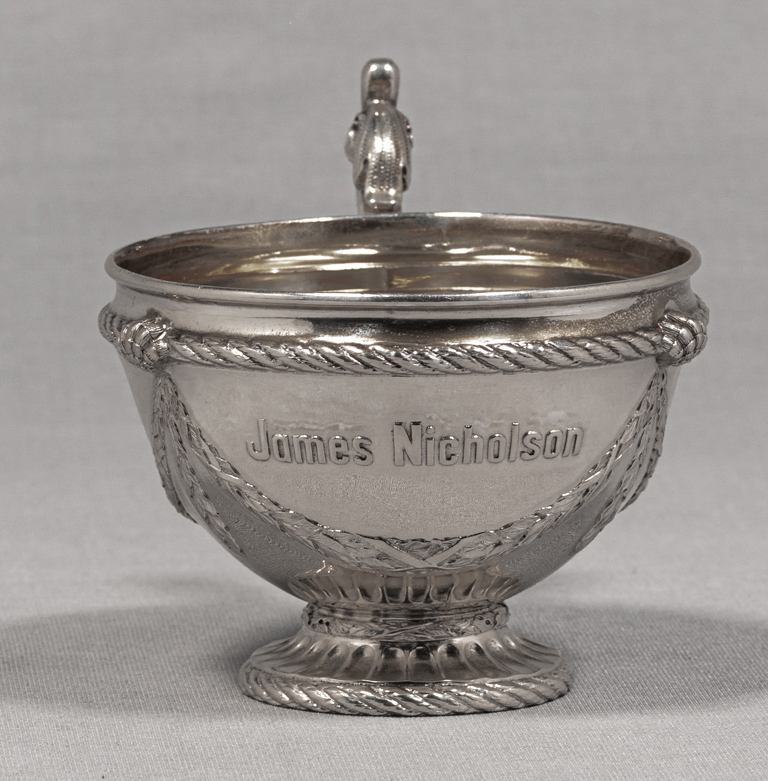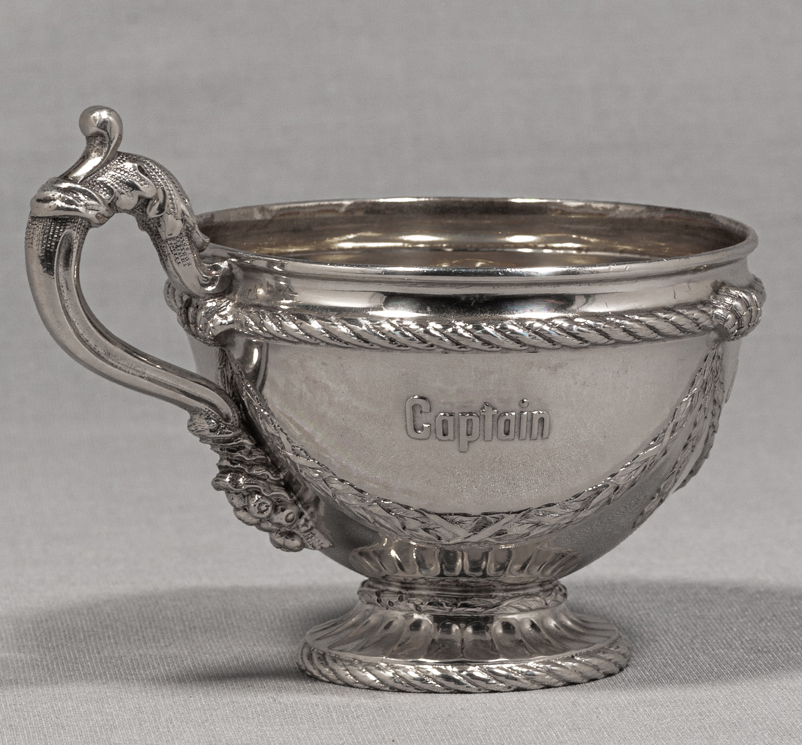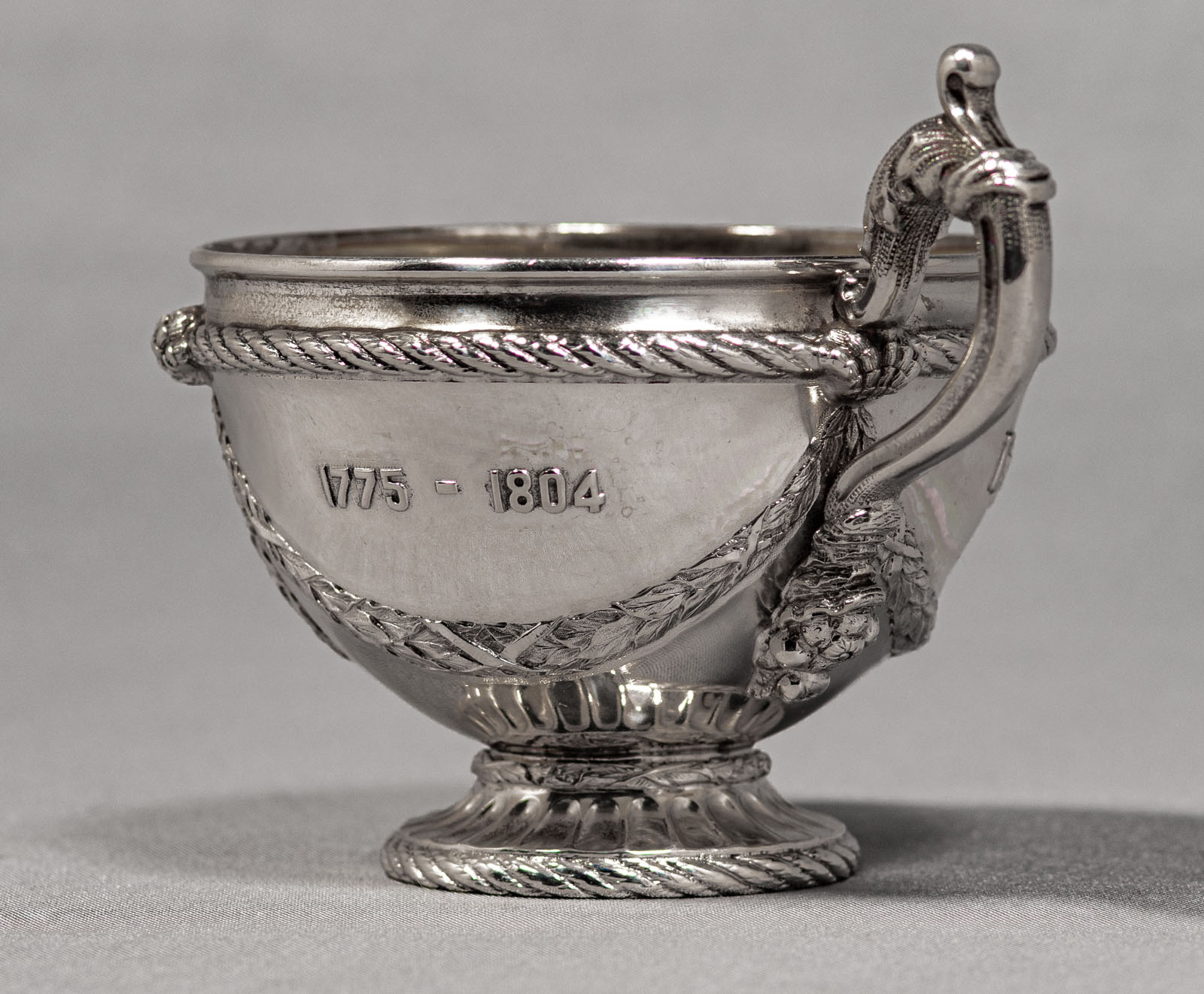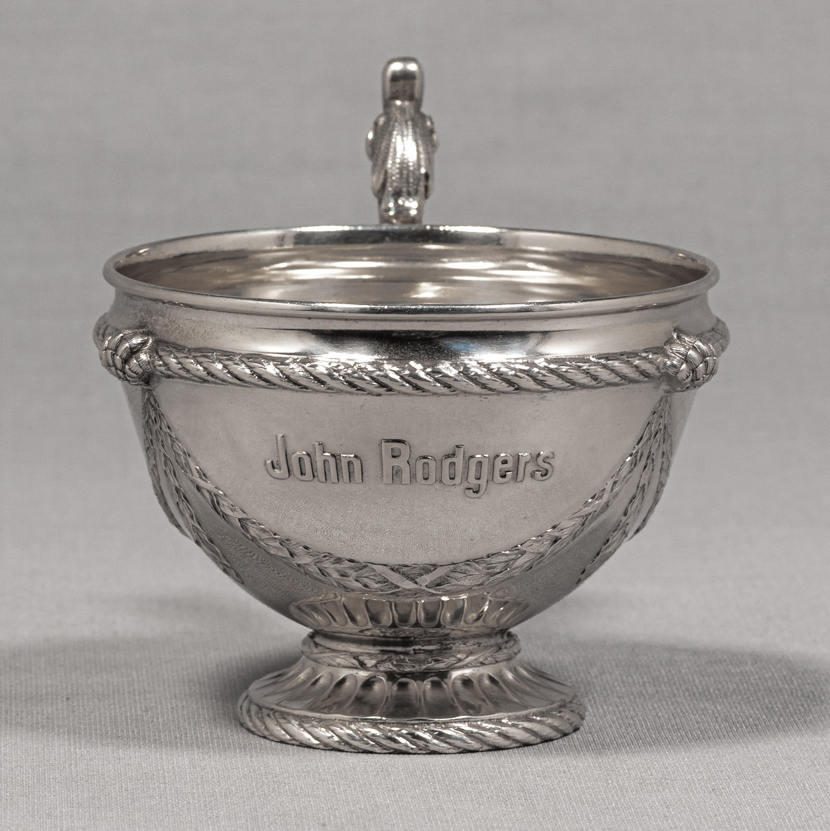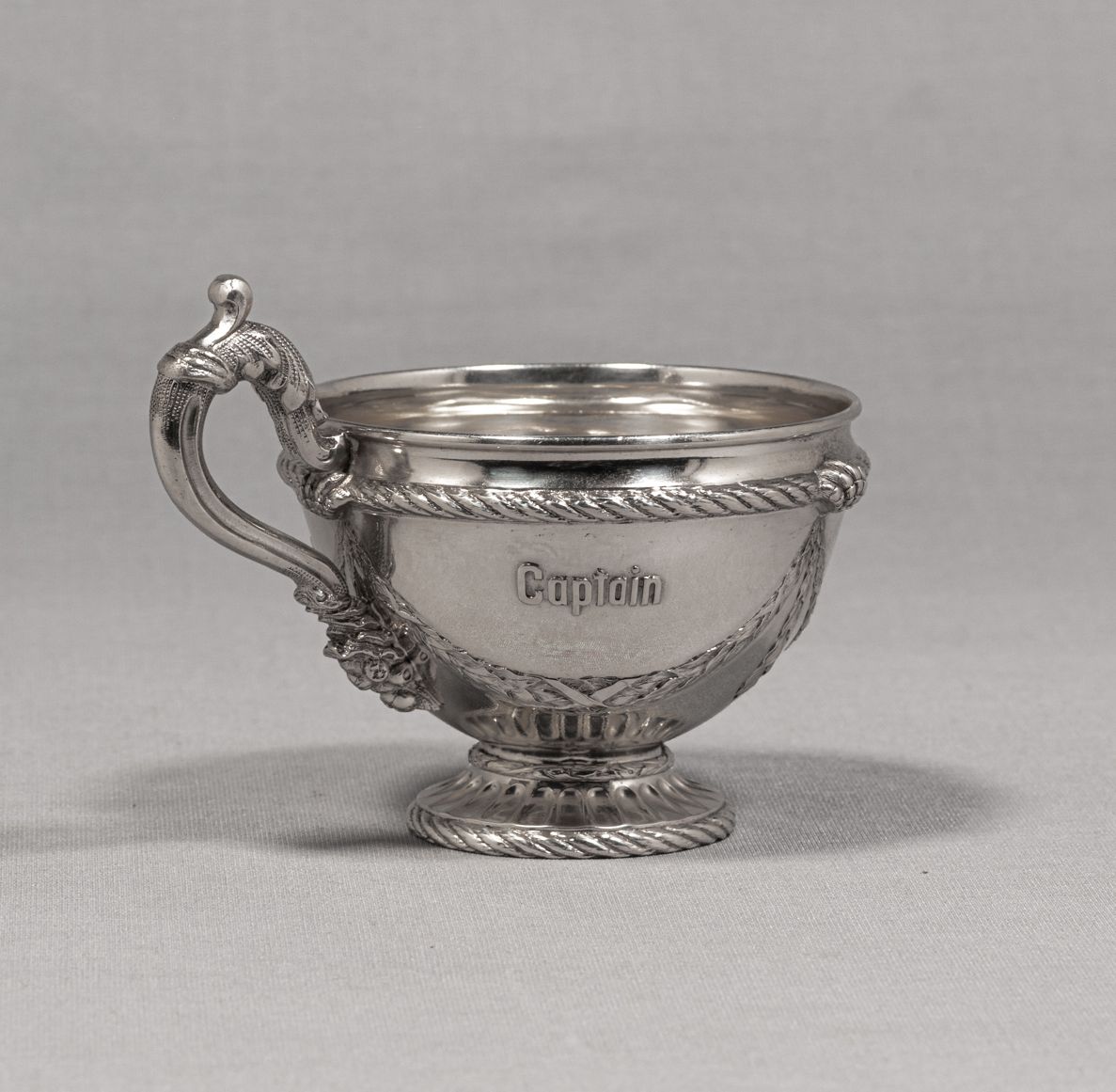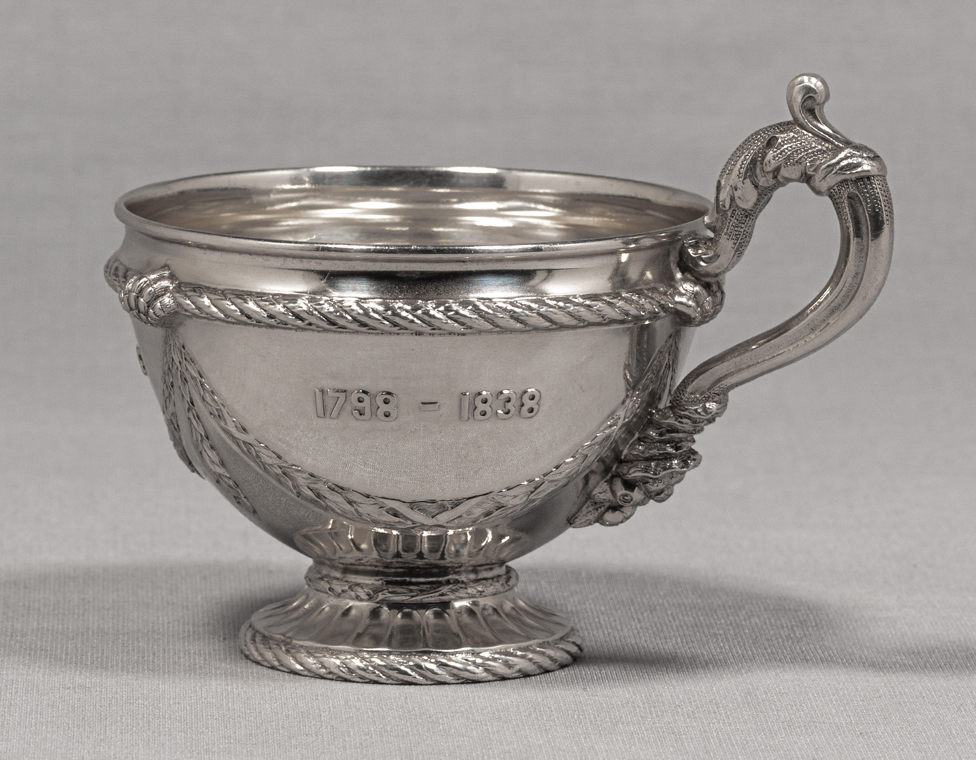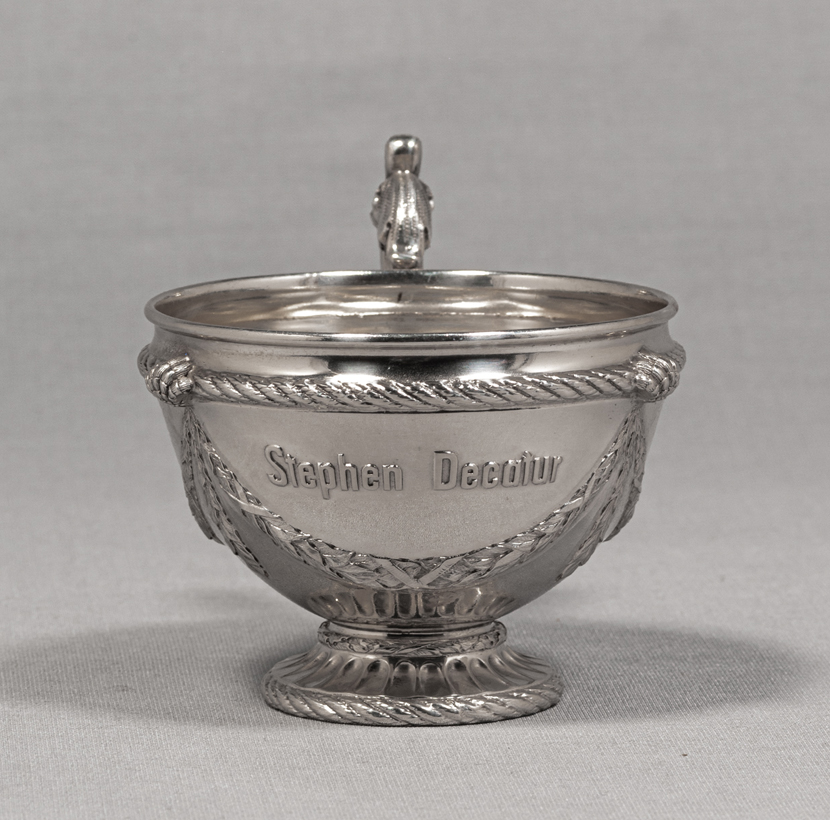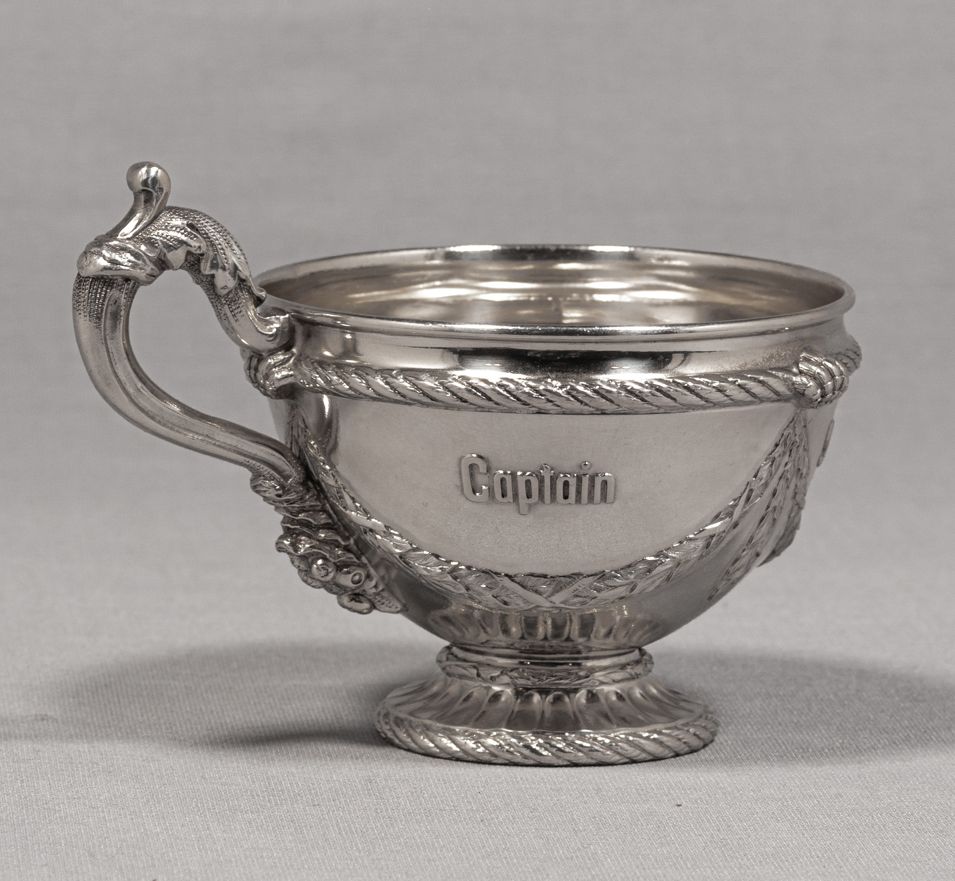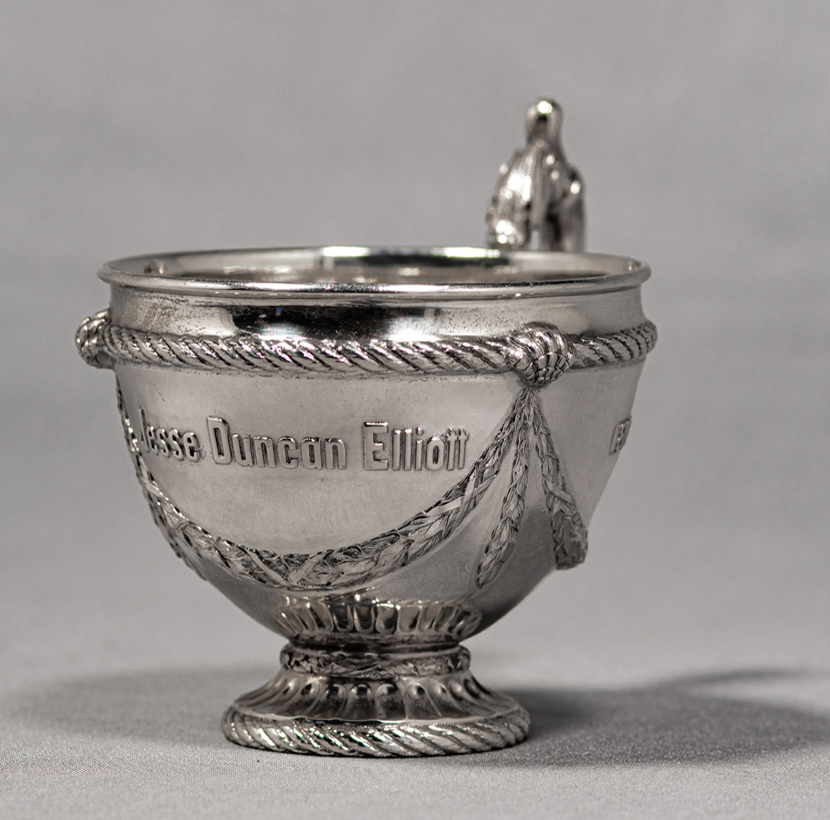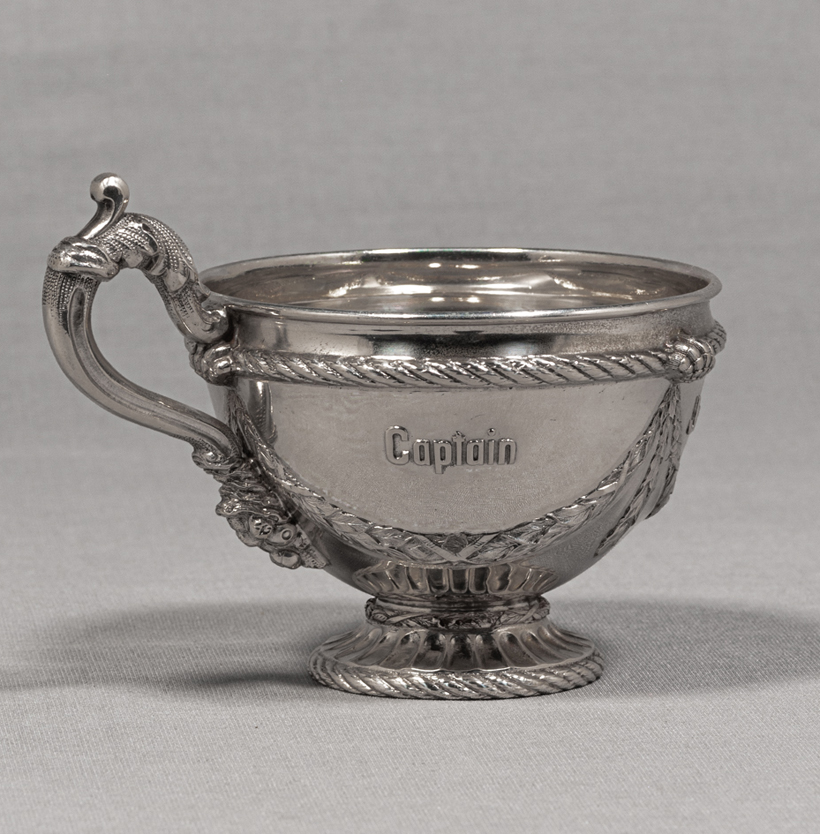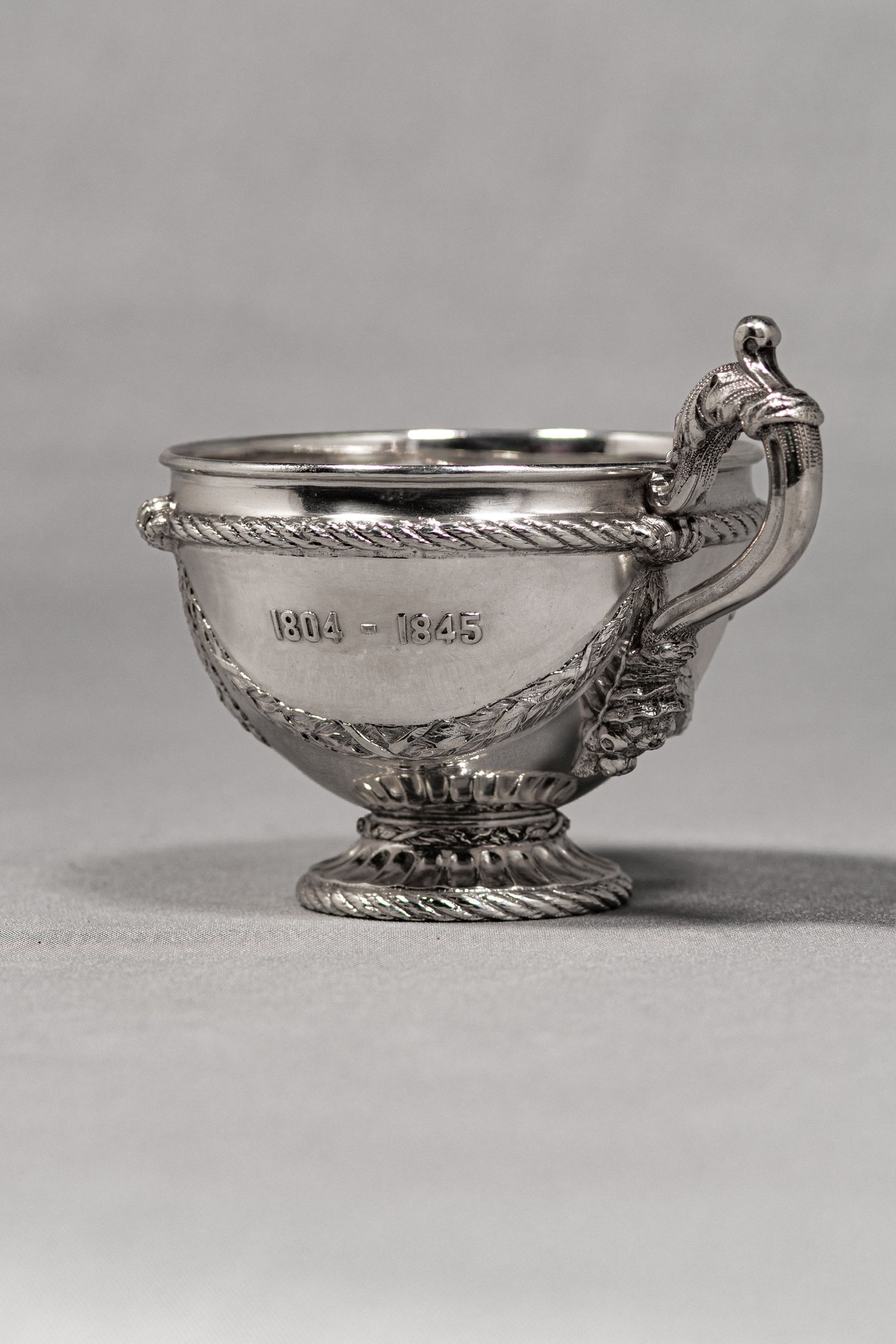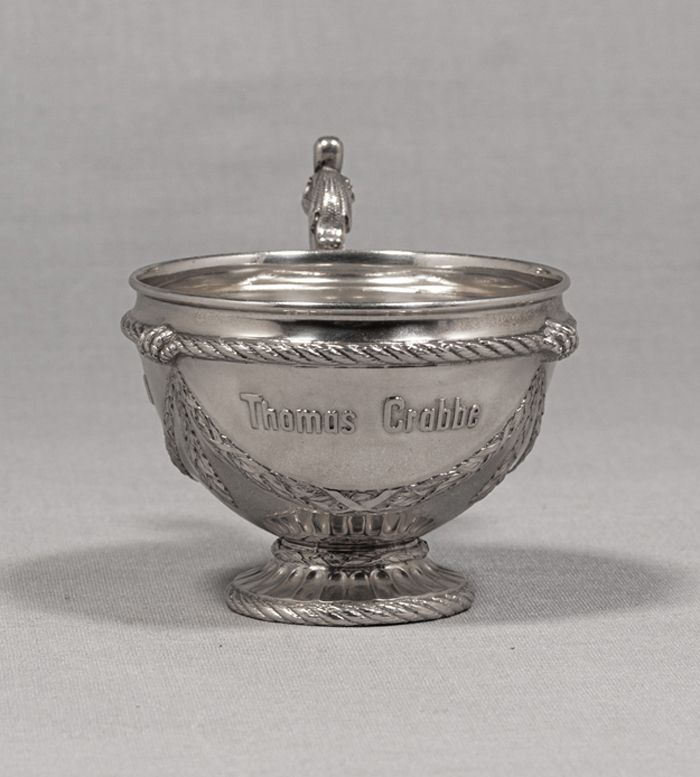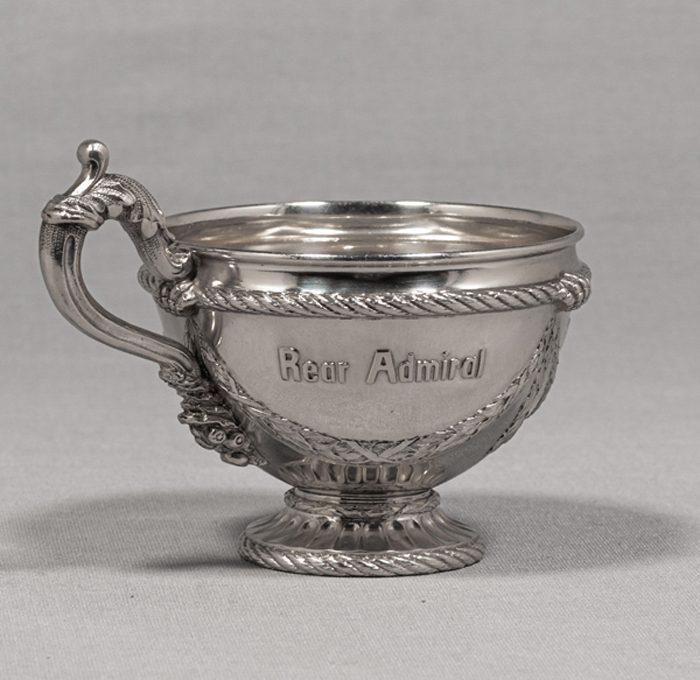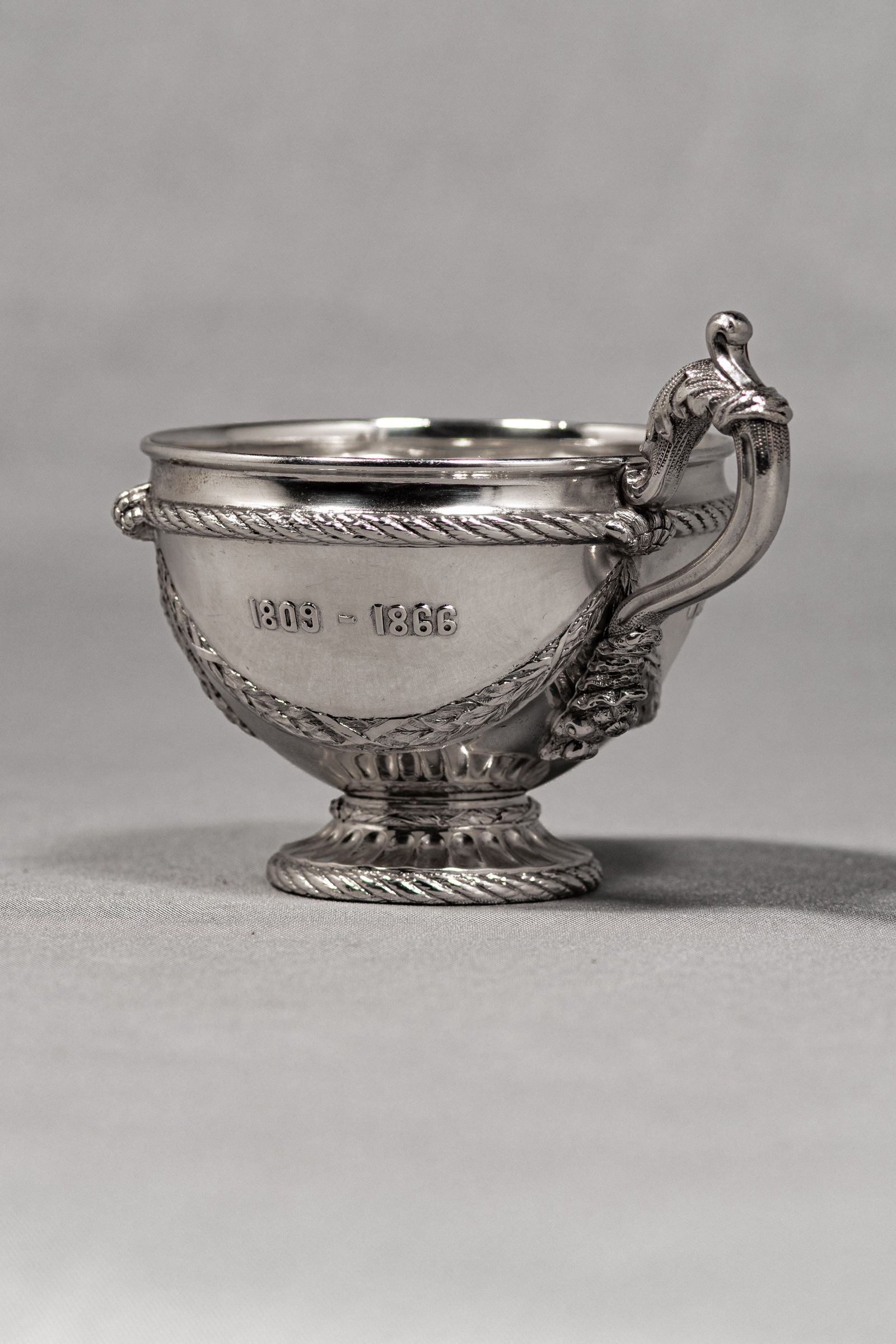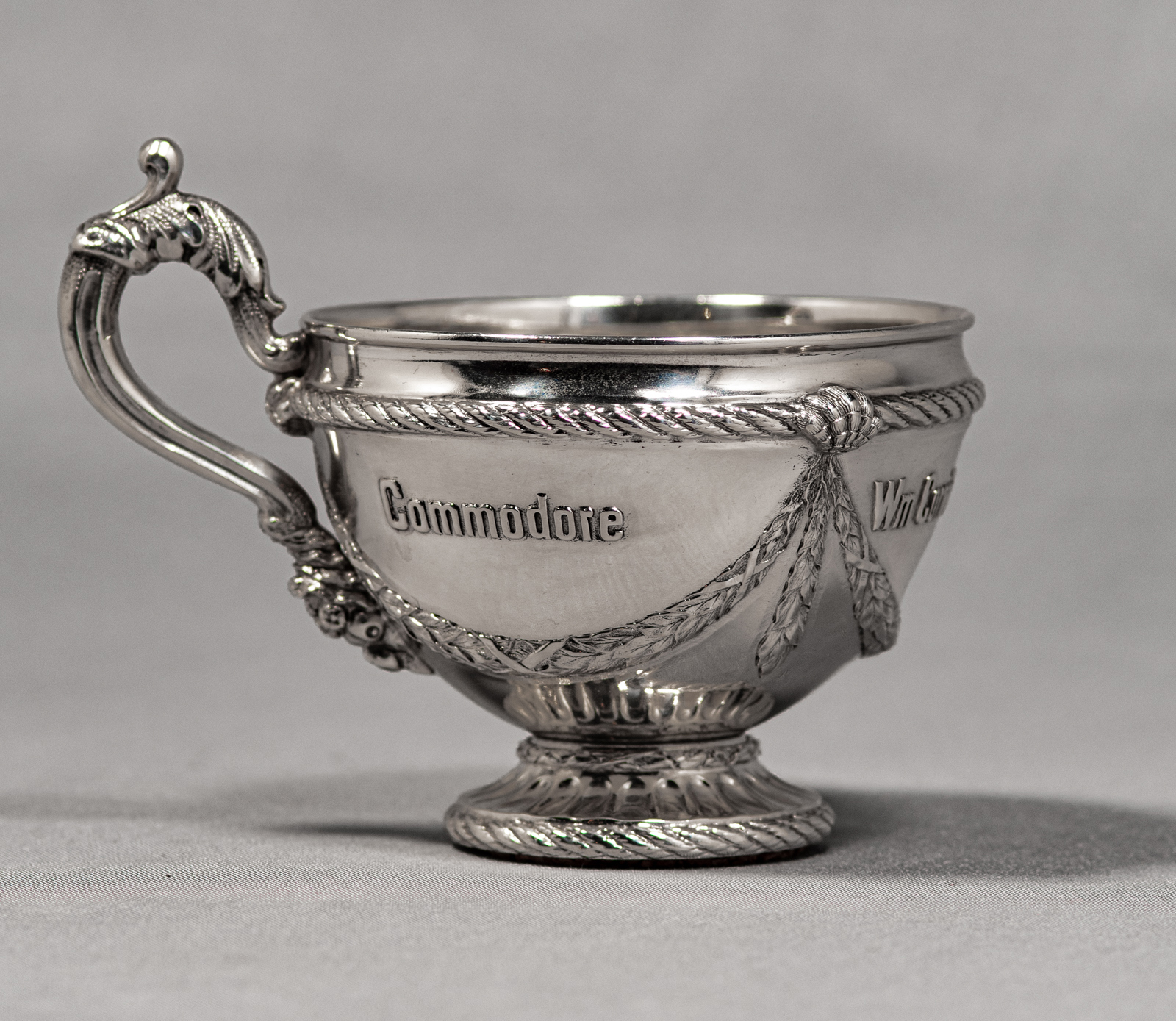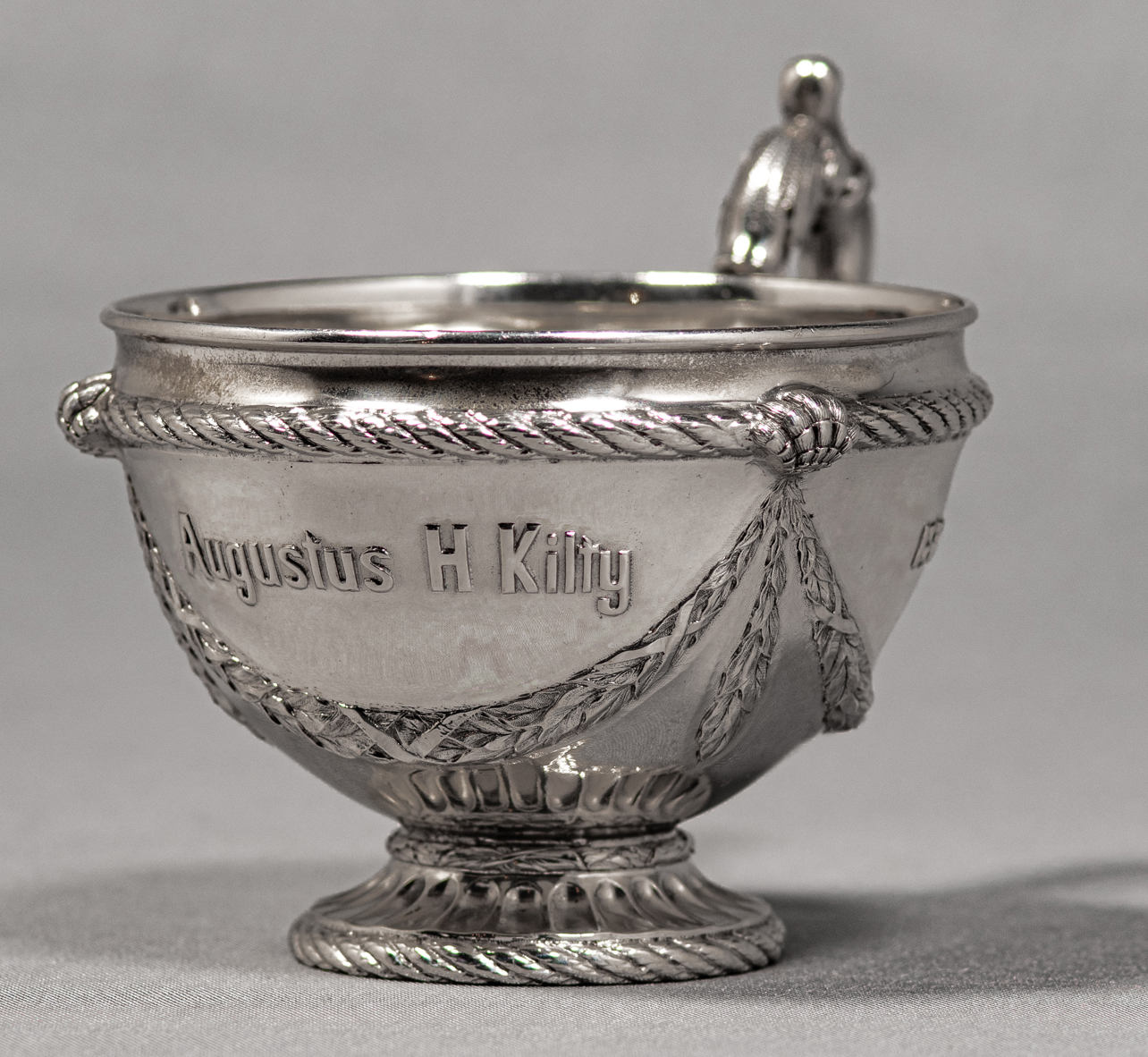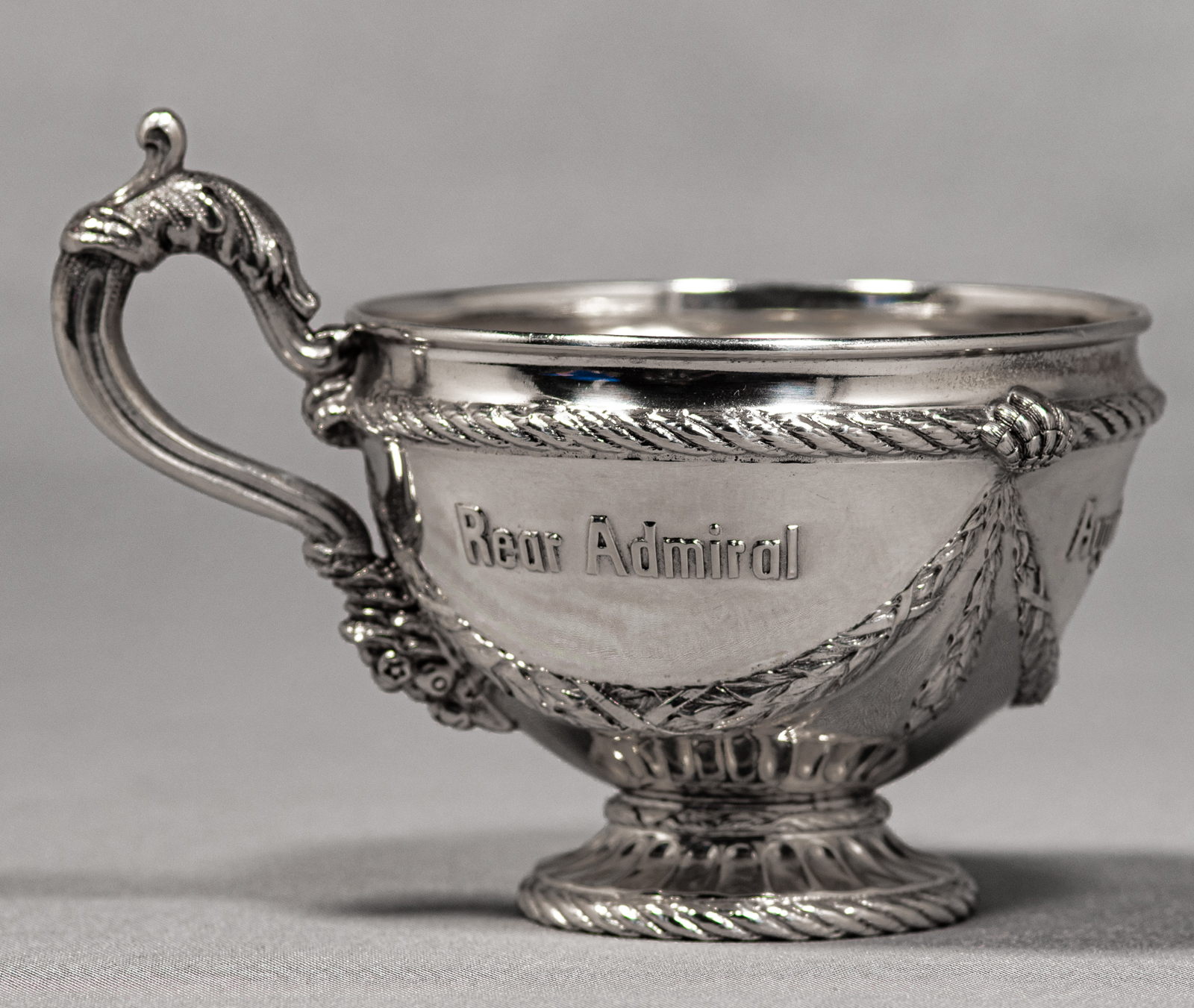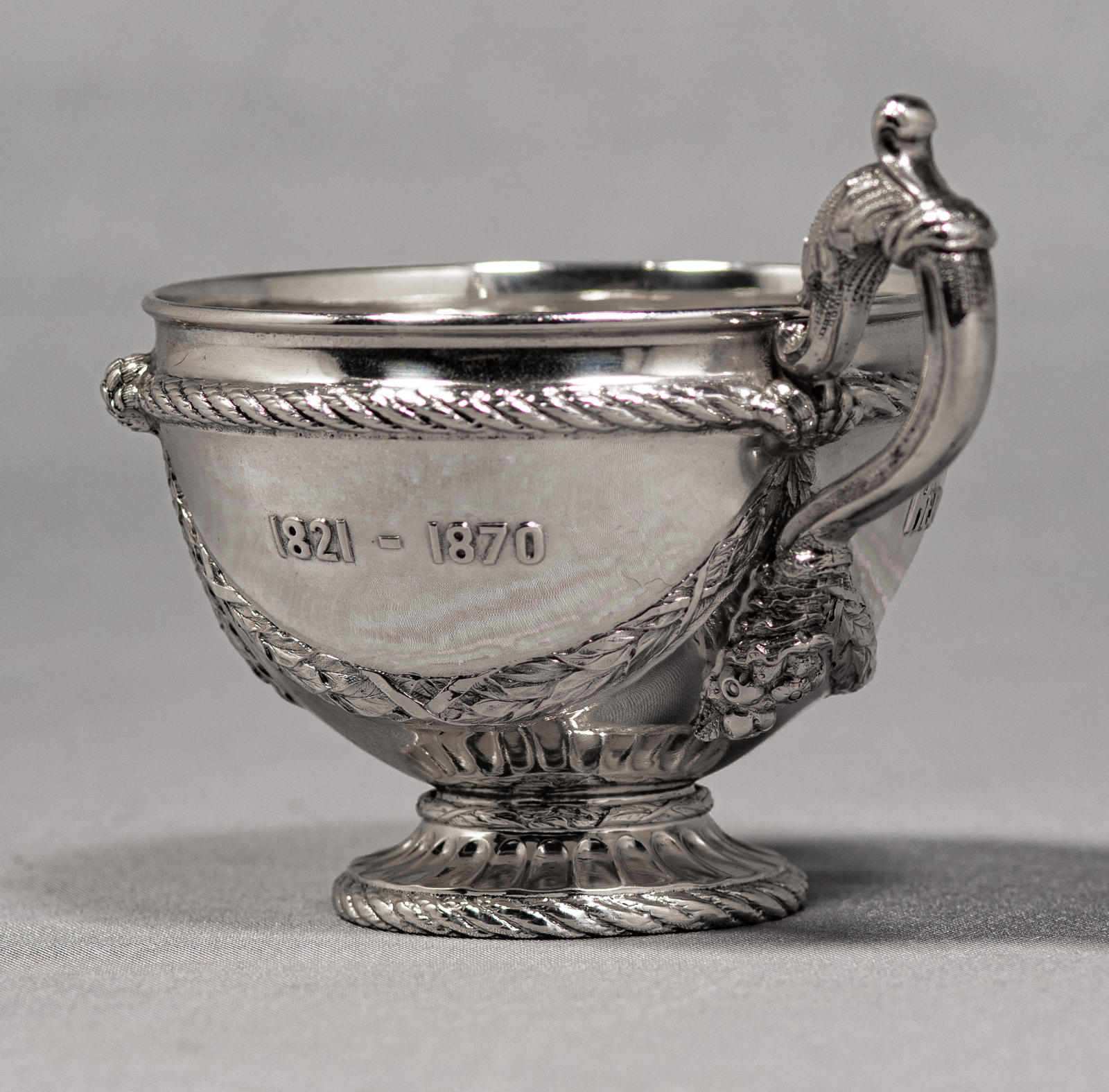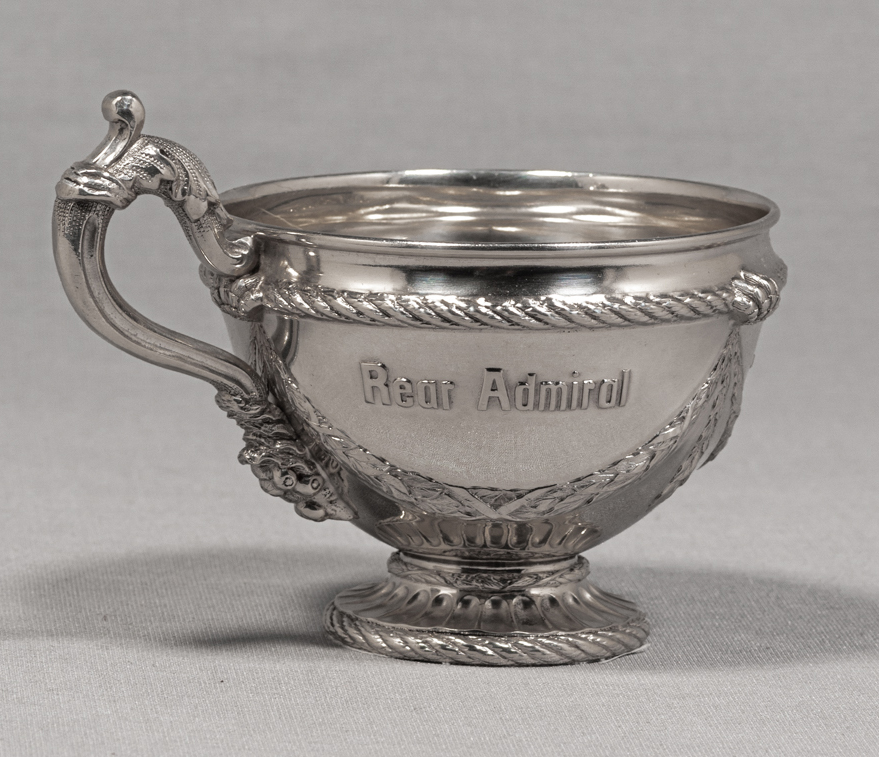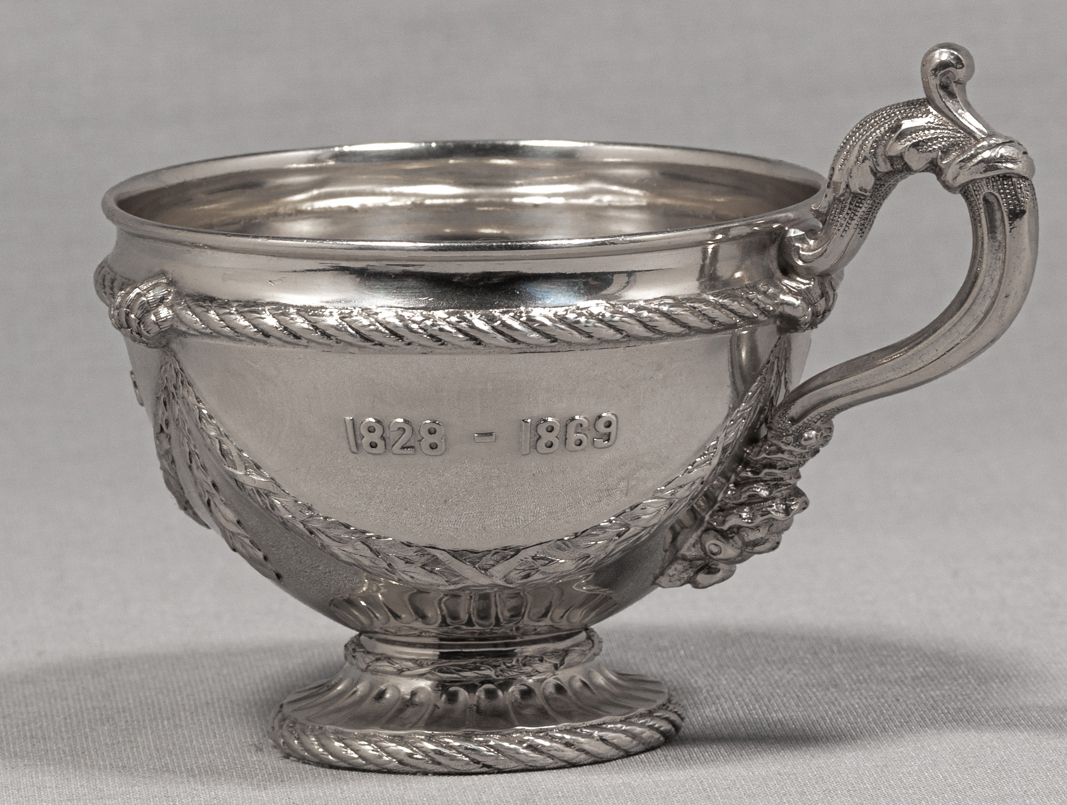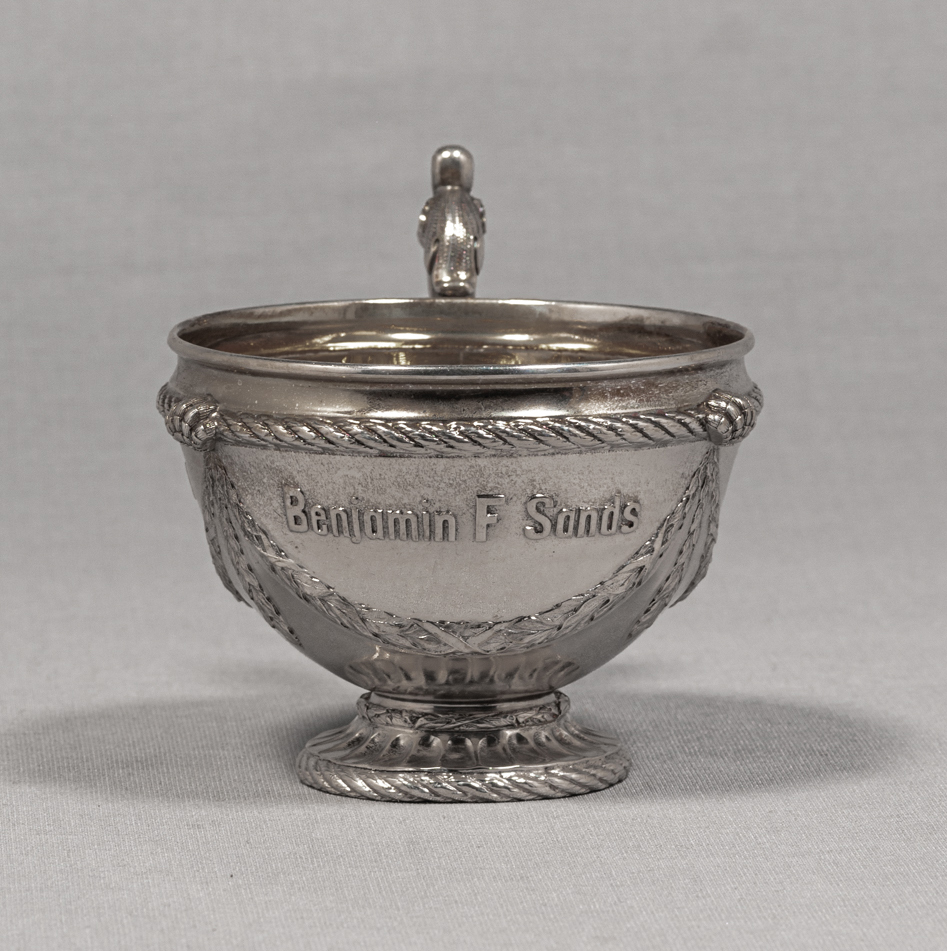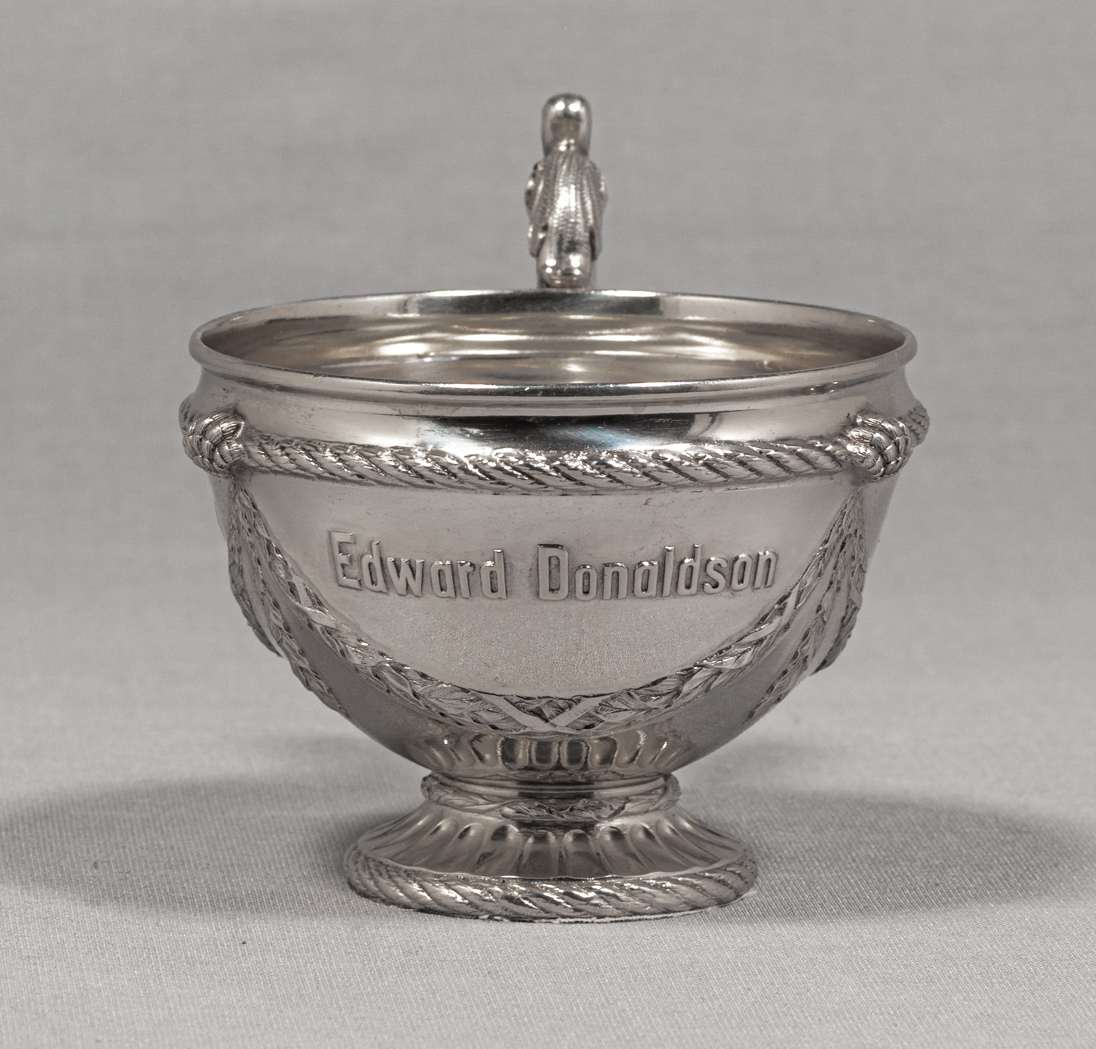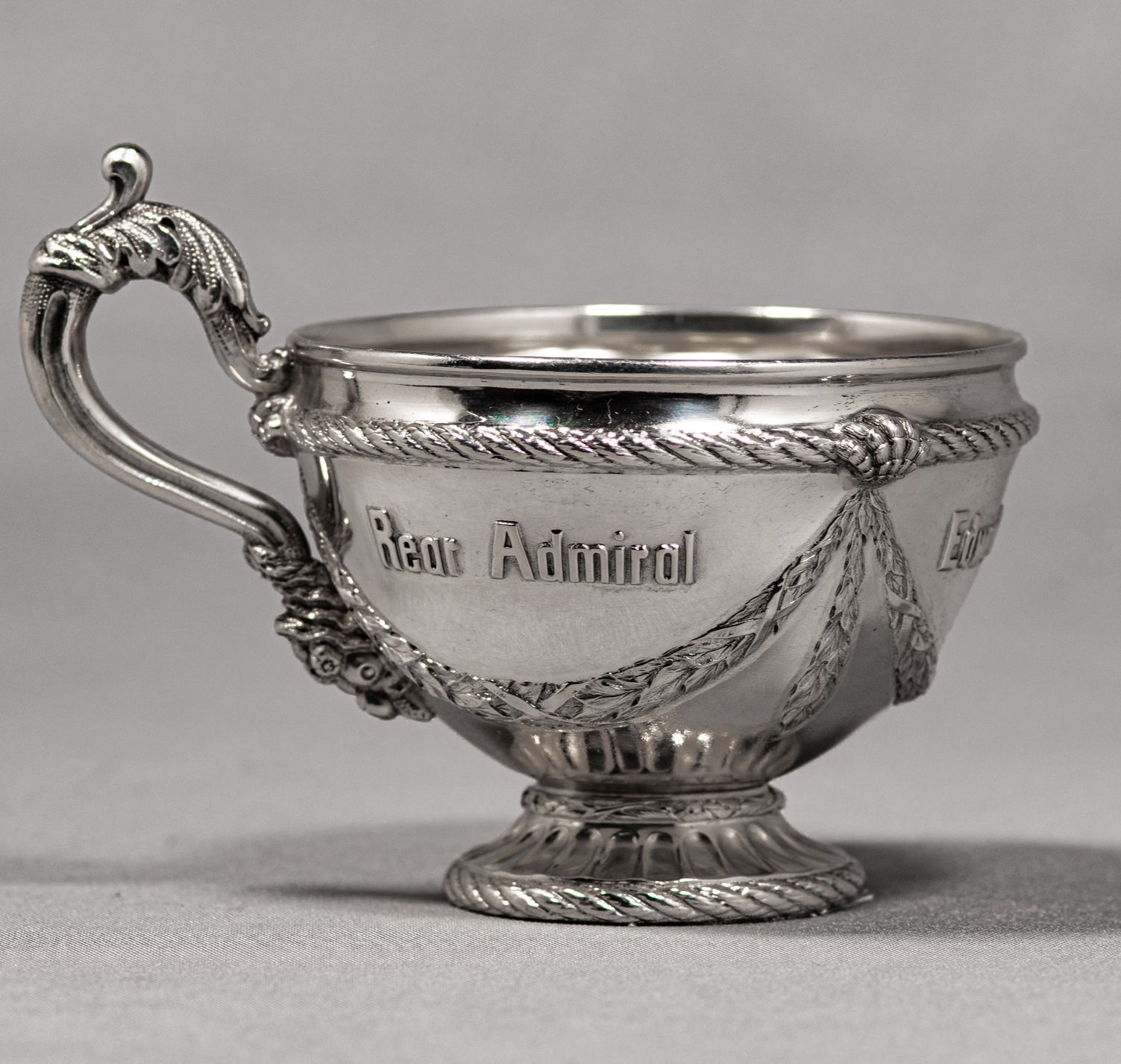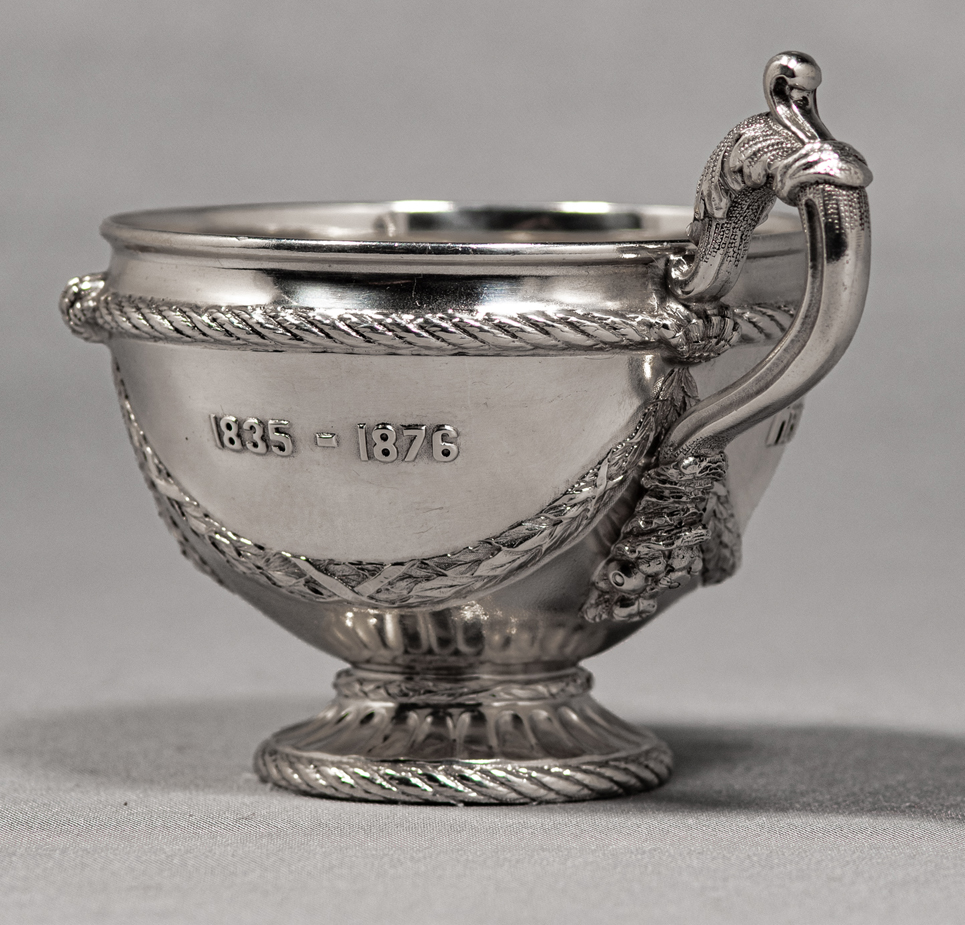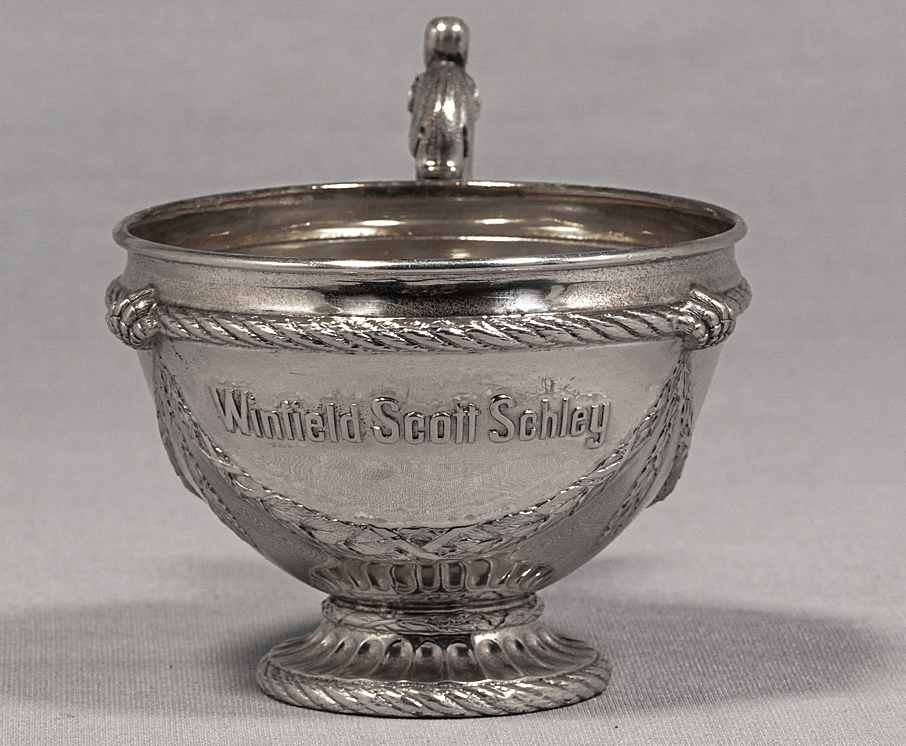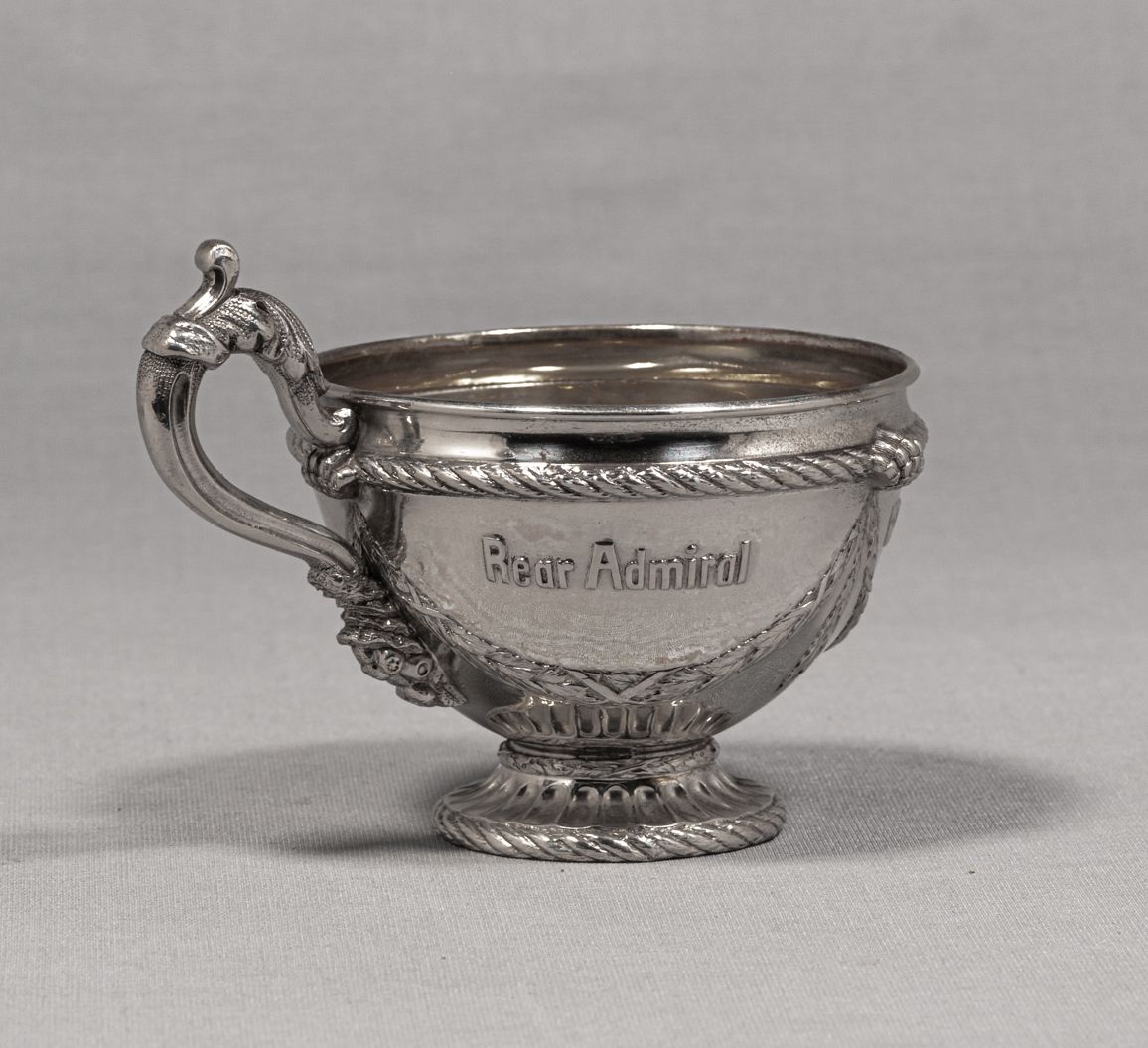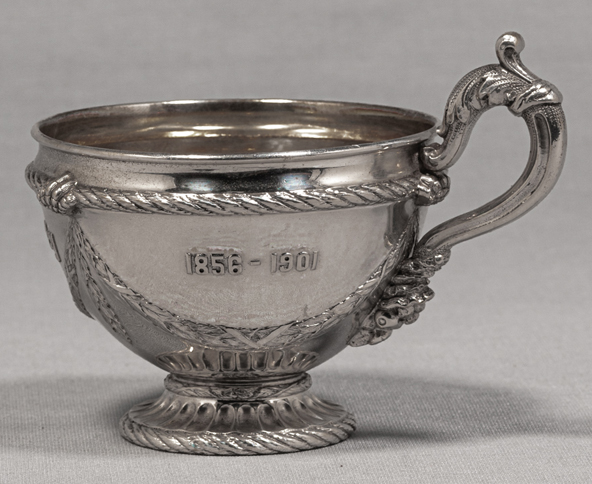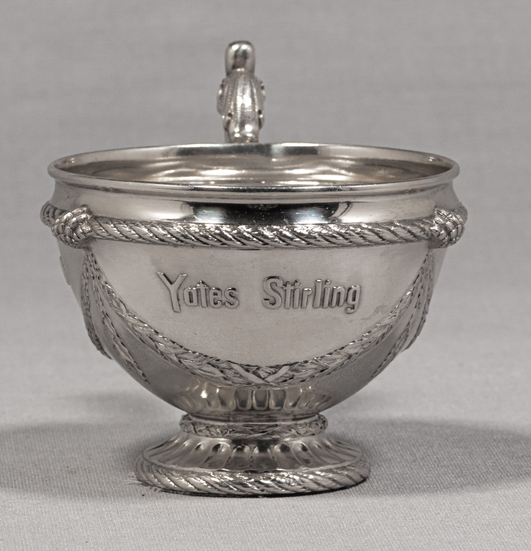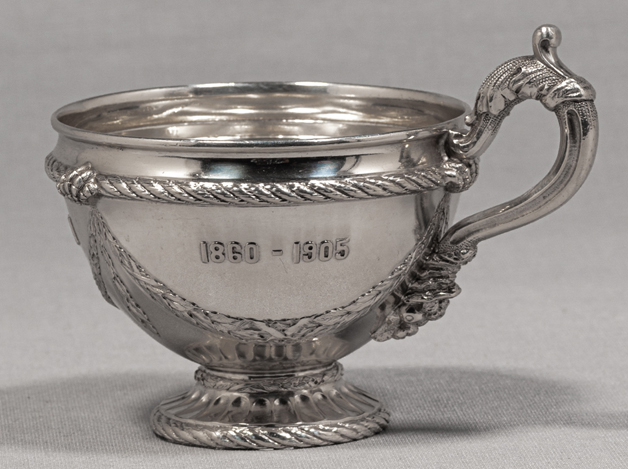Punch Bowl Service, Baltimore City & Baltimore County
From the USS Maryland Silver Service
Jump to:
Complete Set

Maker: Samuel Kirk & Sons (1815-1979)
Objects: Punch Bowl, Plateau and Ladle, Baltimore City
and County
Date: 1906
Medium: Sterling Silver
Accession number(s): MSA SC 1545-0929-1 (bowl), MSA SC
1545-0929-2 (ladle), MSA SC 1545-0929-3 (plateau)
This ceremonial punch bowl, the largest piece in the USS Maryland silver service, represents Baltimore City and Baltimore County. This exceptionally-detailed piece is supported on the plateau by four diamond-back terrapins, and is accompanied by 12 punch cups representing naval heroes from Maryland. Two large eagles with outspread wings sit with their talons gripping the rim above the Great Seal and the Cruiser Maryland. The legal origin of Baltimore County is not known, but it was in existence by January 12, 1659/60 when a writ was issued to the sheriff of the county. Its name derives from the name of the Proprietary's Barony in Ireland in the county of Longford. Baltimore City was incorporated in 1796, and separated from Baltimore County in 1851.
The Great Seal and the Cruiser are surrounded by wreaths of oak, horse chestnut and mulberry. A festoon of tobacco leaves separate each scene, while oyster shells form the border of the bowl. Nine inventions first developed or applied in Baltimore form a “border of progress” across the top of the punch bowl.
This ladle is the largest serving utensil in the silver service.
Punch Bowl:
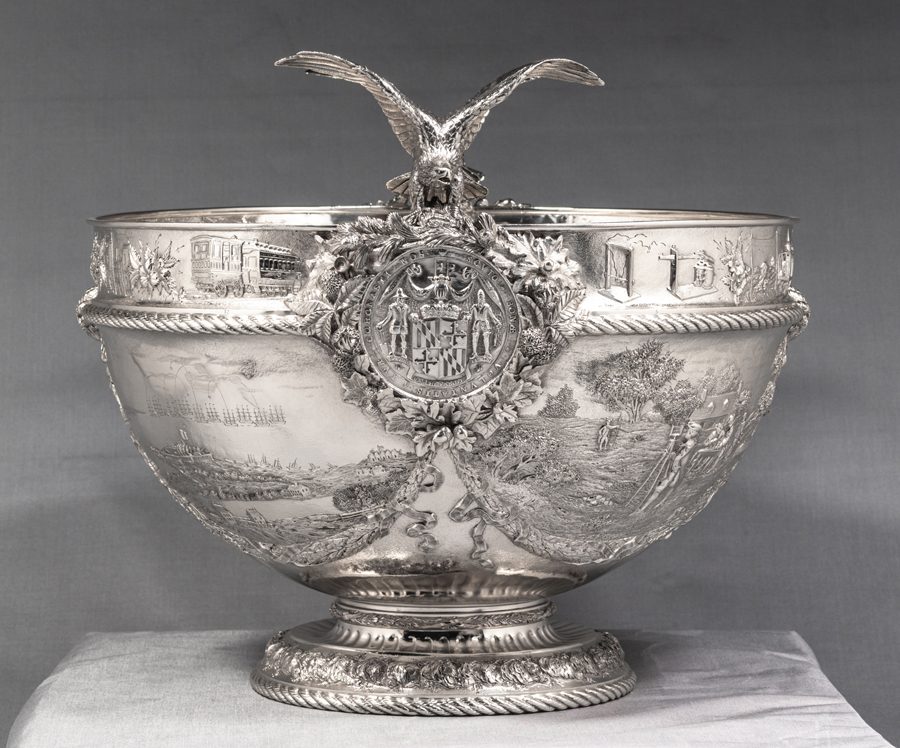
Maker: Samuel Kirk & Sons (1815-1979)
Date: 1906
Medium: Sterling Silver
Dimensions: Overall height, 14"; Overall width (eagle to
eagle) 14"; Overall depth,17 1/2"
Accession number: MSA SC 1545-0929-1
-
Seven Stars Tavern (number 10)
The Seven Stars Tavern was a three-story and attic brick building originally known for its fine oysters and good Maryland rye. More notably however, it was the birthplace of The Independent Order of Odd Fellows, founded by Thomas Wildey and four other men on April 26, 1819. While several other self-instituted lodges had existed in America in the 1800s, Wildey’s chapter was the first to secure an official charter from the Odd Fellowship in England in February 1820.
The tavern used to be located on Second Street, now Water Street, near South Frederick Street. It was destroyed in the Baltimore Fire of 1904, and a historic etching of the tavern was used to create the design on the silver.
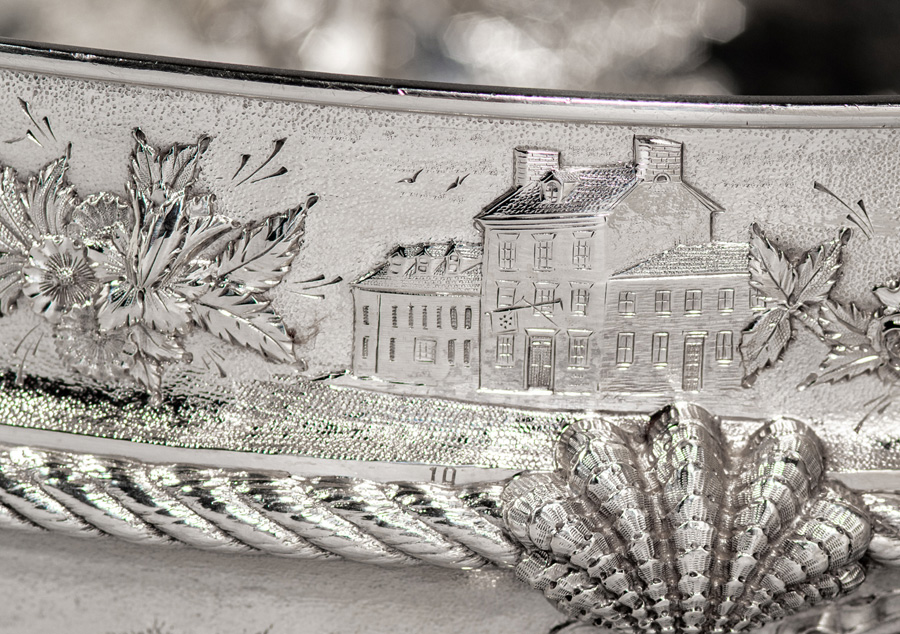
Seven Stars Tavern -
Holliday Street Tavern (number 11)
Between September 14 and 15, 1814 Francis Scott Key penned an untitled song about the British bombardment of Baltimore set to the tune of “To Anacreon in Heaven.” By September 17, printed handbills of the song were circulating around Baltimore, and within a few weeks it was published in seventeen newspapers along the east coast under the title, “Defence of Fort McHenry.” On October 19, 1814 before a seated audience at the Holliday Street Theater in Baltimore, a Mr. Harding sang the song on stage for the first time.The song, later known as the “Star Spangled Banner”, was designated as the National Anthem by Congress in 1931.
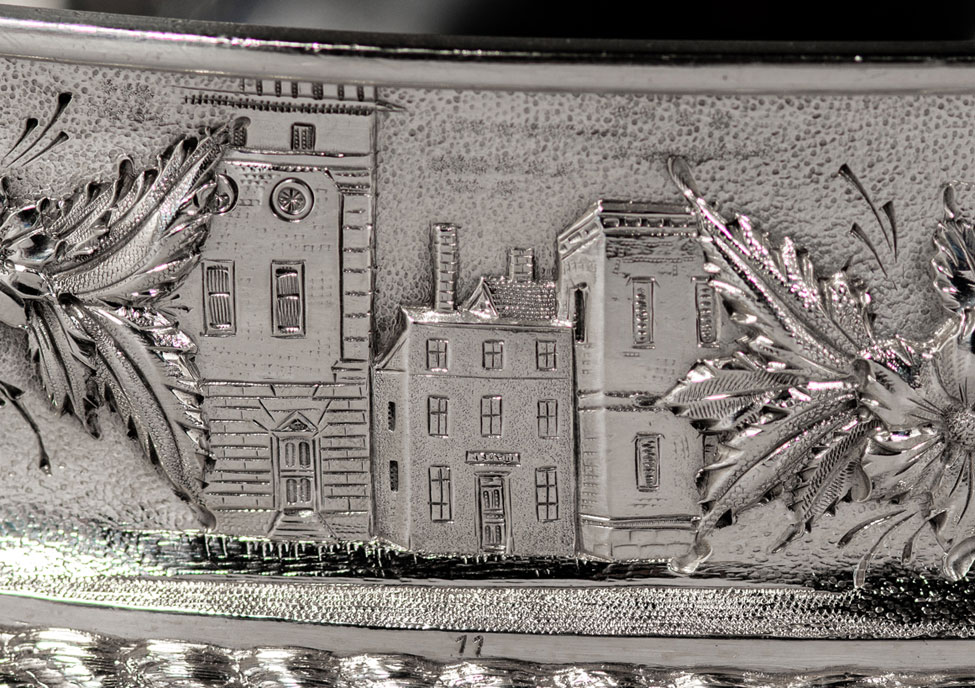
Holliday Street Tavern -
First Electric Railway (number 12)
The first commercially operated electric streetcar in America began operation in Baltimore on August 10, 1885. Originally designed to be used by horse-drawn cars, the Baltimore to Hampden Line with its "unprecedented grades and curves” was converted to operate by cars run off electricity. Leo Draft, a British engineer, designed a three tract system which used electricity from the third rail to power the railway car's motor. The railway line was deemed an instant success, and by 1886 it was carrying around 29,000 passengers a month.
The first two draft motor cars purchased were named "Morse" and "Faraday." A view of the first Daft motor car, with trailer Number Four attached, is shown on the border of the punch bowl.
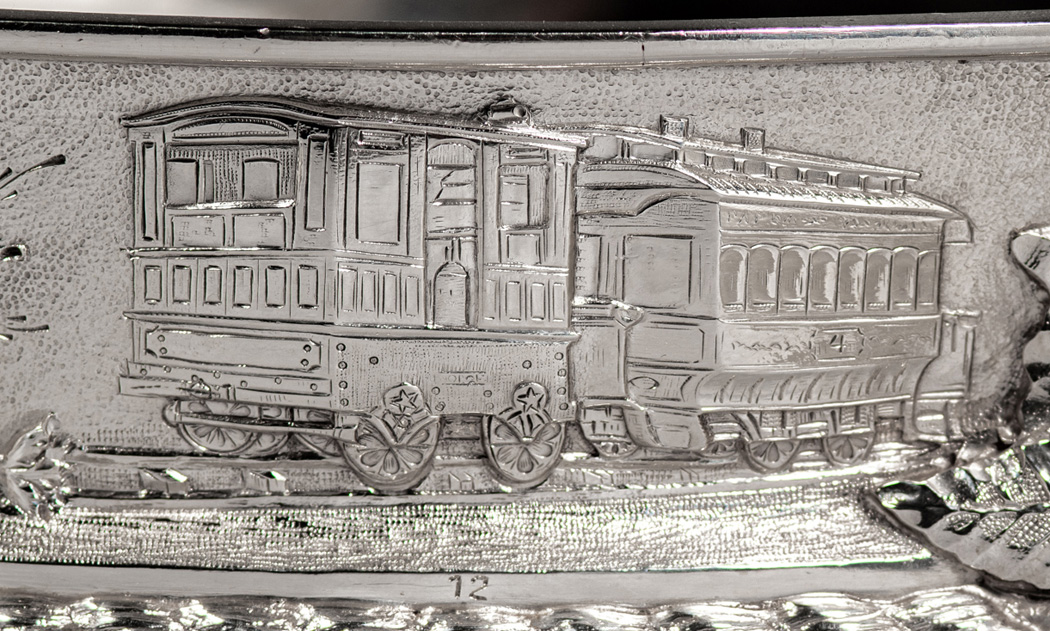
First Electric Railway
- Great Seal of Maryland
-
The First Telegraph Set (number 5)
After twelve years of design and development, the first telegraph message in the United States was transmitted on above ground poles between Washington D.C. and Baltimore on May 23, 1844. Samuel F.B. Morse sent the message "What hath God wrought” to his partner Alfred Vail.
The original transmitting and receiving sets are now at the Smithsonian Institution and are also depicted on the pieces from Calvert, Charles, Somerset, St. Mary’s, and Wicomico counties.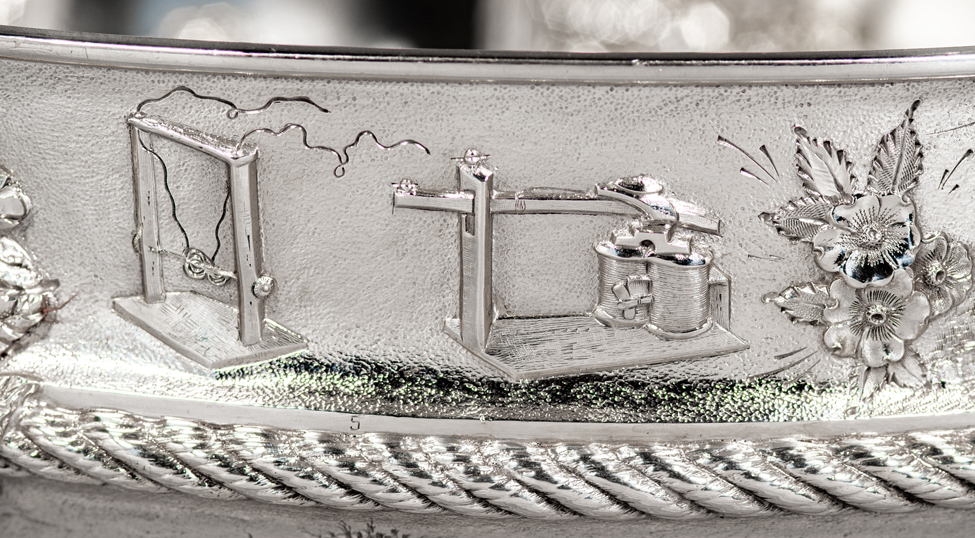
The First Telegraph Set -
Peter Cooper Locomotive (number 6)
While steam powered locomotives had been in use in England, their engines were not sufficient to haul heavy loads up the steep terrains that existed in Maryland, so the Baltimore & Ohio Railroad (B&O) relied on horses to pull its trains. On August 28, 1830 inventor and businessman Peter Cooper debuted his coal-burning locomotive, known as “Tom Thumb.” Showcasing it on the B&O’s newly constructed railroad tracks from Baltimore to Ellicott Mills (now Ellicott City) Cooper’s invention was successfully able to make the journey.
To the astonishment of all present, the locomotive made the 13 mile trip (one way) in just 57 minutes. While the locomotive was used only for a year before being salvaged for parts, its design led the way for future locomotives and revolution of travel in the United States.
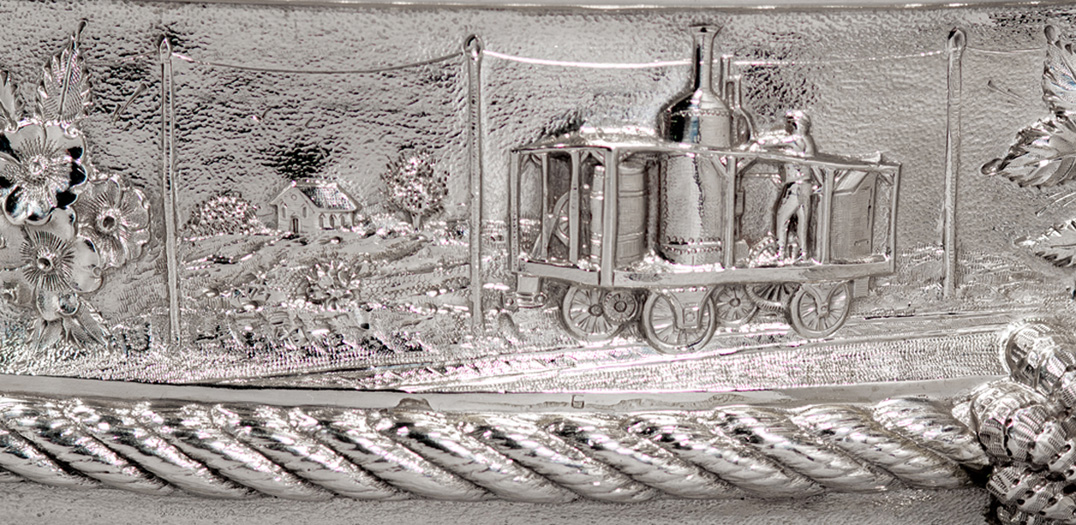
Peter Cooper Locomotive -
First Electric Railroad (number 7)
By 1888, the Baltimore and Ohio Railroad found it necessary to connect several of its tracks to cause minimal disruption and eliminate the dense smoke caused by steam locomotives, it was decided to bore an underground tunnel and use an electric train. Baltimore had led the country in the first electric street cars in 1885 and was determined to continue the trend.
To accomplish this feat required the design, engineering, and construction of an electric locomotive to be more powerful than others built at that time, using technology that was less than six years old, as well as creating electric power generation and distribution facilities. It would take almost seven years for the tunnel and locomotive to be operational.
The scene on the border of the punch bowl shows the electric powered locomotive "B&O Number One", with a train in tow, emerging from the Howard Street Tunnel on June 27, 1895.
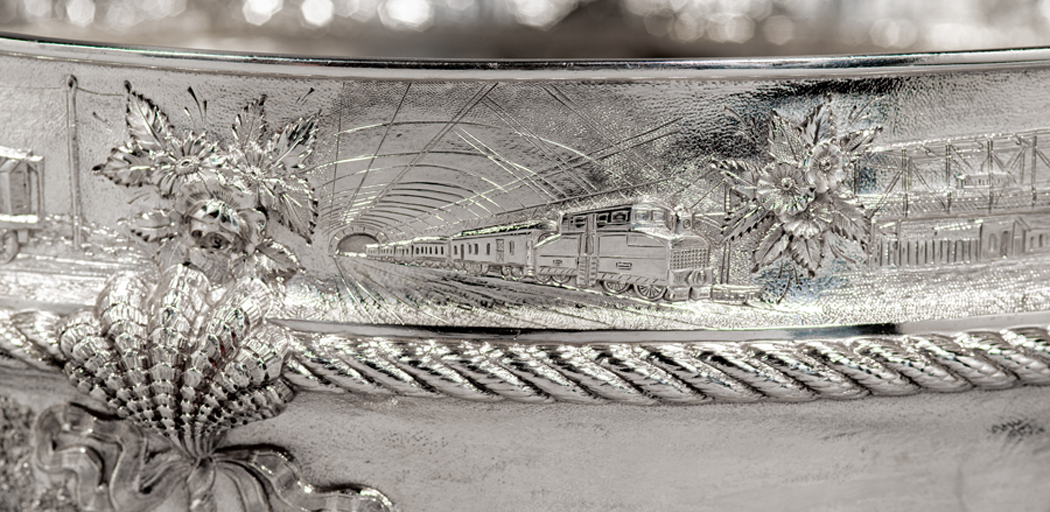
First Electric Railroad
-
Bombardment of Fort McHenry (number 2)
After a series of victories, British forces set their sights on the third largest city in the United States at that time, Baltimore. On September 12, 1814, British land forces began their assault north and east of the city in the Battle of North Point. They encountered city defenses and ultimately decided the American position was too strong for a land-based attack. Instead, the British moved their fleet of sixteen ships to a position just over two miles from Fort McHenry, where 1,000 American troops were waiting to defend Baltimore.
Out of range of the defending guns, the British began one of the longest bombardments in North American history, starting at daybreak on September 13th until 7:00 a.m. on September 14th without ceasing. Once the bombardment ended, the American garrison flag at Fort McHenry was still raised over the Fort, indicating that the battle had been won by the Americans which inspired Francis Scott Key to write the “Star Spangled Banner.”
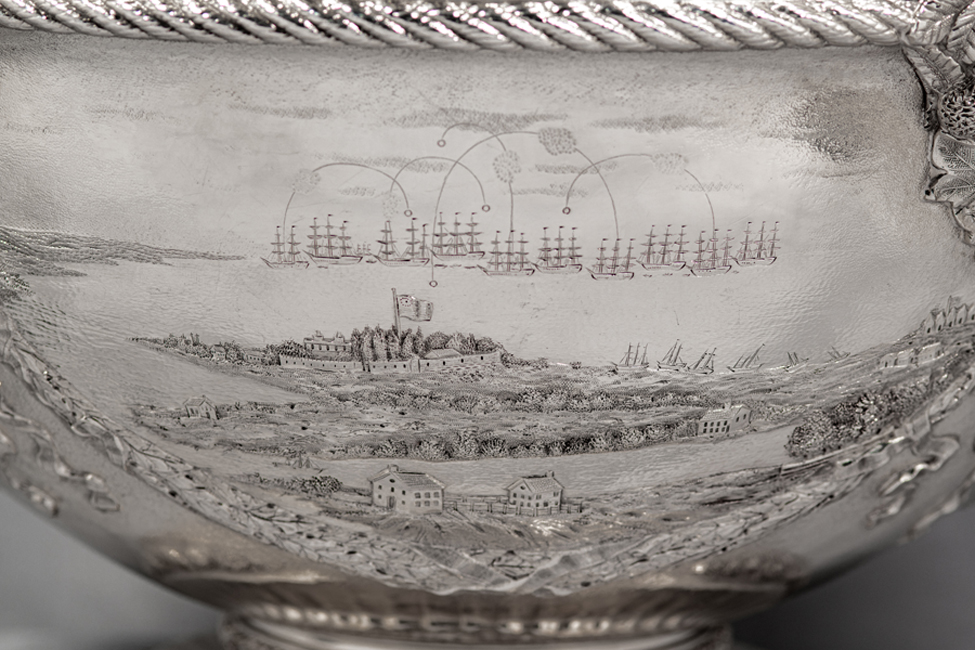
Bombardment of Fort McHenry
-
Laying out of Baltimore Town (number 4)
The scene below and to the right of the Great Seal portrays the surveyors at work laying out Baltimore. In 1729 an Act was passed providing for "Erecting a Town on the north side of the Patapsco, in Baltimore County, and for laying out into lots sixty acres of land […]”. County surveyor Philip Jones began laying out Baltimore Town into one acre plots in January 1730. Each acre sold for forty shillings in money or tobacco at the rate of one penny per pound. The survey provided for three main roads through the town, which were Baltimore, Calvert and Charles Streets with an additional nine lanes.
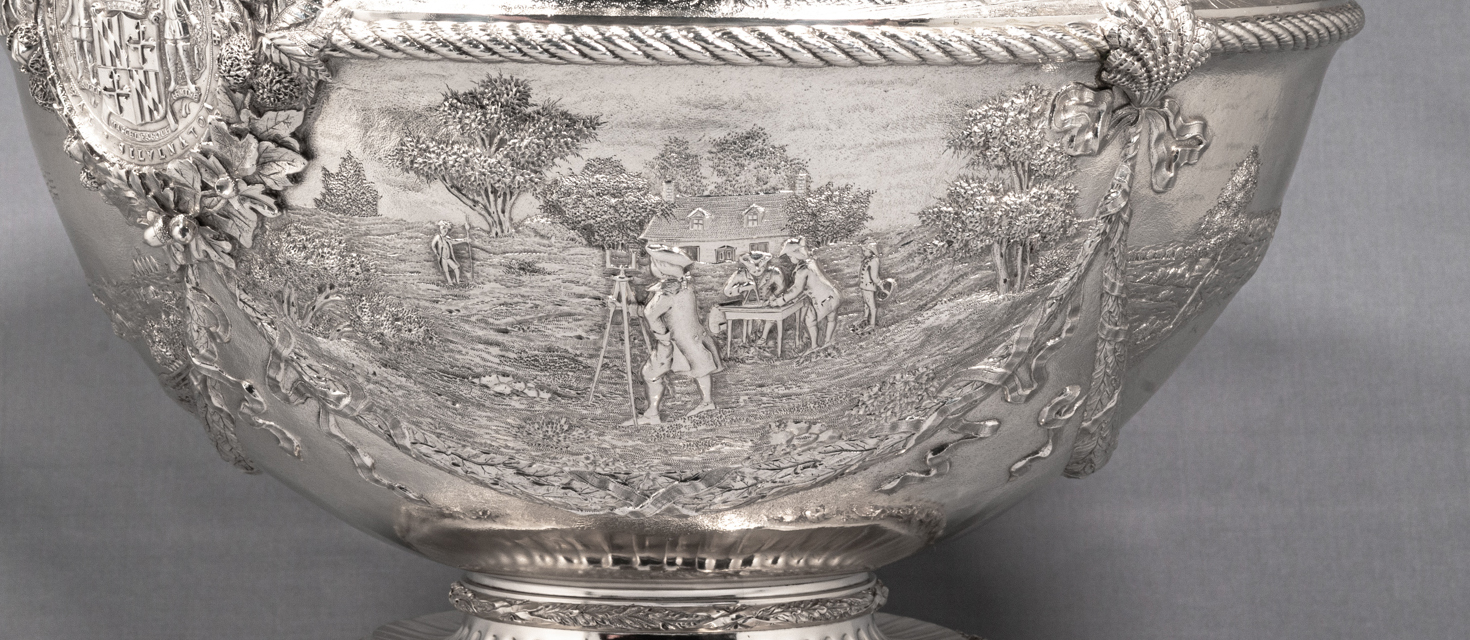
Laying out of Baltimore Town
-
First Gas Street Lamp
(number 13)
Artist Rembrandt Peale dazzled visitors to his museum in Baltimore with gas lighting in June 1816. Peale’s light was brighter and less smoky than whale oil lamps and was so successful that the mayor signed an ordinance allowing the newly formed Gas Light Company of Baltimore to create gas street lamps just 8 days later. On February 7, 1817 the first gas street lamp in the United States was lit at the intersection of Baltimore and Holliday streets — then known as Market and Lemmon streets.
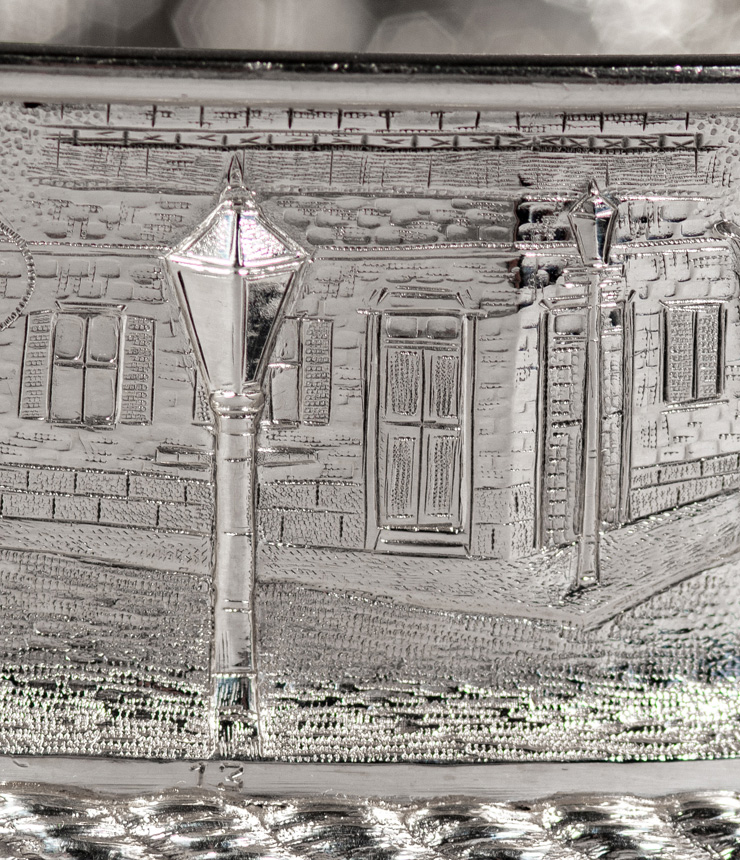
First Gas Street Lamp -
Birth of the Star Spangled Banner (number 9)
Lawyer Francis Scott Key was on board a ship in the Chesapeake Bay during the bombardment of Fort McHenry in mid-September 1814 where he watched from afar. Inspired by the resilience of the American flag over Fort McHenry, Key penned a song that would later be known as the “Star Spangled Banner” which was designated as the National Anthem by Congress in 1931.
Measuring 30 feet by 42 feet, the large garrison flag Key wrote about was ordered by the commander of Fort McHenry a year before the bombardment. It took seven weeks for Mary Pickersgill, numerous family members, a 13-year-old African-American indentured apprentice named Grace Wisher, and possibly an enslaved person whose name we do not know, to make the flag.
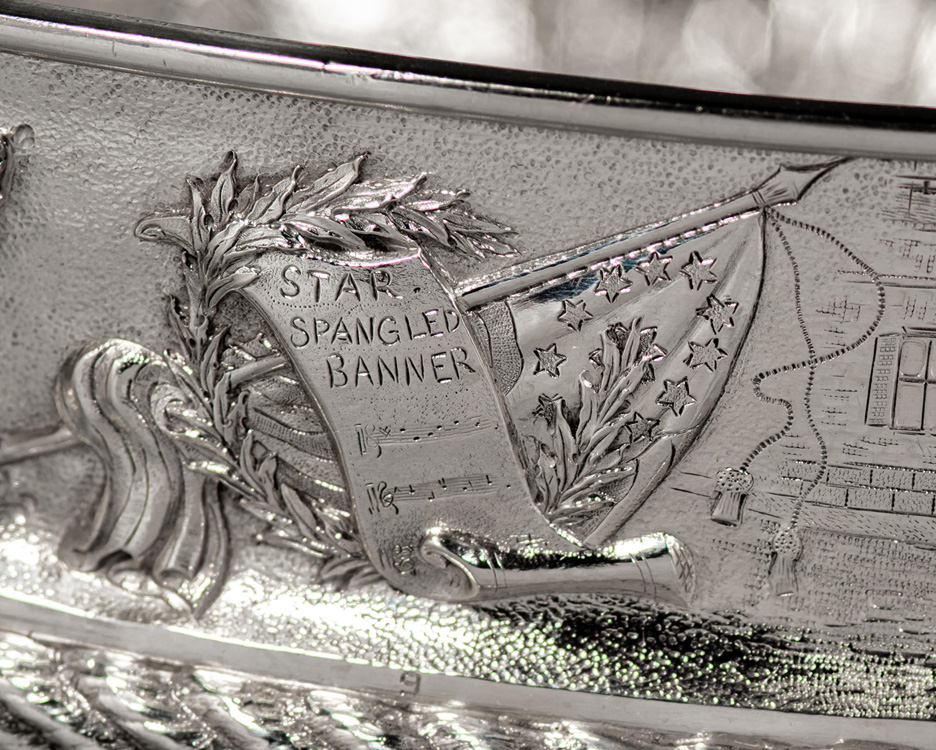
Birth of the Star Spangled Banner -
First Elevated Railroad (number 8)
An overcrowded rail network of tracks in Baltimore meant expansion was impossible on the ground, so the Lake Roland Company took to the air to create the first electrified elevated line in the country. The line ran 4,000 feet along Guilford Avenue from Lexington to Chase Street. After opening to much excitement on May 6, 1893, its last day of operation was New Year’s Day in 1950 before it was dismantled six months later.
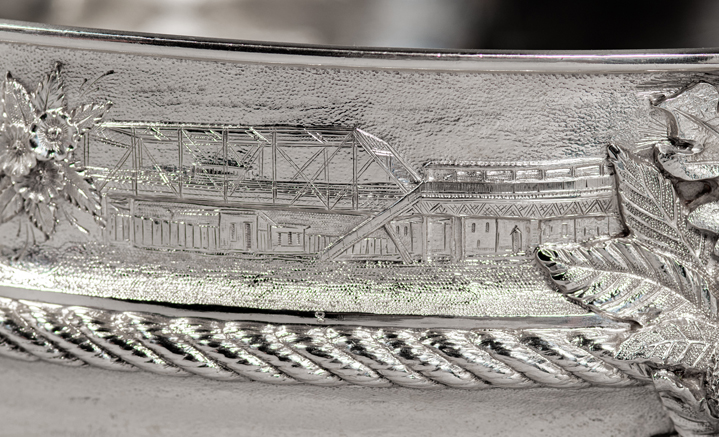
First Elevated Railroad
-
Baltimore in 1752
(number 1)
Initially 60 acres when first surveyed in 1730, the land provided for Baltimore Town had expanded to nearly 103 acres by 1752, by which there were about 20 dwellings and a population of 100 people. Baltimore Town continued to grow due to its commercial and residential potential, attracting a diverse group of immigrants and people from other colonies.
By 1768 it had a population of over 1,200 and was designated as the county seat of Baltimore County. As the population steadily increased to over 6,000, Baltimore Town merged with Jones Town and Fell’s Point in 1773 before incorporating into the City of Baltimore in 1796. Baltimore City was formally separated from Baltimore County in 1850.
An 1817 engraving, “Baltimore in 1752” by William Strickland was the basis for the scene on this section of the punch bowl. The two ships in the harbor represent the whole of the locally owned merchant marine at that time. The larger vessel is the “Phillip and Charles” and the other is the sloop “Baltimore”. Calvert Street and several other roads are visible as well.
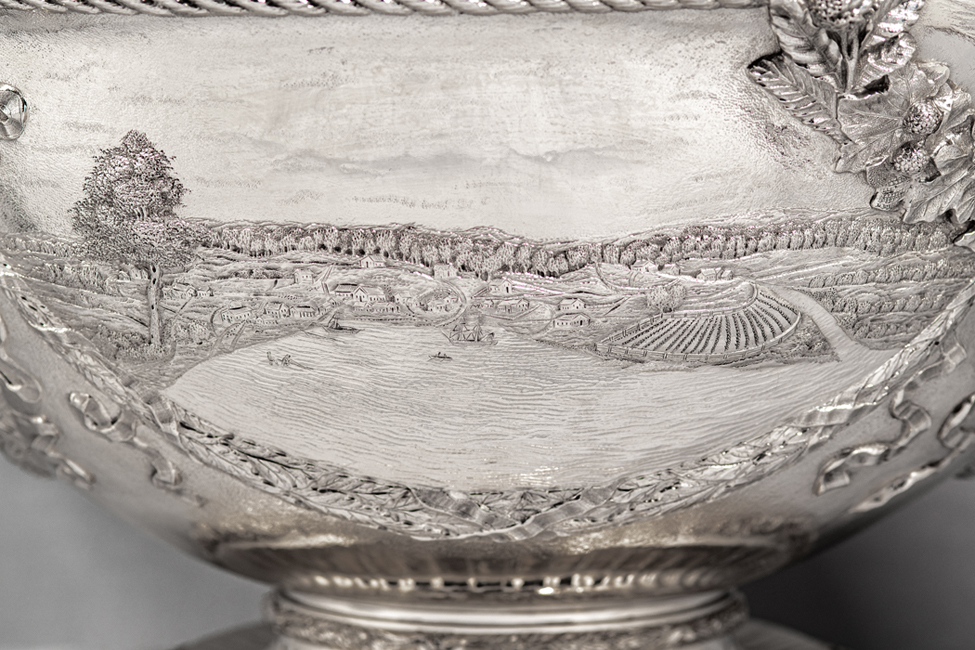
Baltimore in 1752 - USS Maryland Cruiser
-
Washington Monument (number 3)
The Washington Monument in Mount Vernon Square, Baltimore was likely the first major architectural monument to honor George Washington when built from 1815-1829. Designed by architect Robert Mills, (who would later go on to design D.C.’s Washington Monument) on land donated by a Maryland revolutionary war hero, it took marble from three quarries to complete the 178 foot tall monument. Italian-born sculptor Enrico Causici carved the 14 foot statue of Washington, who is depicted in the act of resigning his commission as Commander-in-Chief over the Continental Army, an event which had occurred in the Maryland State House.

Washington Monument
Punch Cups

Maker: Samuel Kirk & Sons (1815-1979)
Objects: Punch Cups (12), Baltimore City and County
Date: 1906
Medium: Sterling Silver
Dimensions: Overall height, 3 ½”; Overall width, 4 7/8”;
Diameter of top, 3 ½”; Diameter of base, 1¼”
Accession number(s): MSA SC 1545-0929-4 through MSA SC
1545-0929-15
The USS Maryland silver service includes twelve punch cups that were intended to be used in conjunction with the Baltimore City and County punch bowl. Although only four punch cups are presently displayed on the plateau, all twelve cups can be placed on the plateau.
Each cup is engraved with the name, rank, date of entry into the Navy, and death date of a different naval hero from Maryland (although some cups use the date they achieved their highest rank instead of death date). Many of the naval heroes fought in conflicts with great significance in the 19th century.
-
Captain James Nicolson (1775-1804)
James Nicholson (1737- 1804) was born in Chestertown, Maryland. During the American Revolution, Nicholson joined the Continental Navy. Later, he became the most senior captain in the Navy and named commodore-in-chief of the Continental Navy. During his career, Nicholson commanded the ships “Defense”, “Virginia”, and "Trumbull." After the war, Nicholson was a U.S. Commissioner of Loans from 1801 until his death in 1804.
- Captain John Rodgers (1798-1838)
John Rogers (1772-1838) was born on a farm in Cecil County and was raised in Havre de Grace, Maryland. He was a senior naval officer during the formative years of the United States Navy and served under six presidents for nearly four decades. His commands include the “John Adams”, “President”, “Constitution”, “Insurgent”, “Maryland”, and “Guerriere”.
In 1799 Rogers went to Baltimore to supervise the outfitting and command of a new vessel, the (first) USS “Maryland”; a sloop-of-war with 20 guns. By the War of 1812, Rogers was a seasoned naval leader and played an important role in the successful American defense of Baltimore against the British. After the war he was appointed by congress to serve as the first President of the Board of Navy Commissioners from 1815–24.
While the punch cup itself may say Captain, Rodgers actually achieved the rank of Commodore.
- Captain Stephen Decatur (1798-1820)
Stephen Decatur, Jr. (1779-1820) was born off Sinepuxent Bay, in Worcester County, Maryland. The son of a Naval Commodore, he entered early into naval service. Decatur served under three presidents and in both Barbary Wars in North Africa, the Quasi-War with France, and the War of 1812. Promoted at age 25, he is the youngest man to reach the rank of captain in the history of the United States Navy
Decatur is best known for the February 16, 1804 action in Tripoli when, as a lieutenant, he and 75 Sailors set fire to the captured “Philadelphia” during a raid on Tripoli harbor. Decatur served as Navy Commissioner from 1816−1820, was the recipient of congressional recognition, and numerous awards. Decatur died in a duel at age 41 in March 1820, in Washington, D.C.
- Captain Jesse Duncan Elliott (1804-1845)
Jesse Duncan Elliott (1782-1845) was born in Hagerstown, Maryland. Elliott first enlisted in the Navy in 1804 and was promoted to the rank of Captain in 1818. He was commander of American naval forces in Lake Erie during the War of 1812 and served in both Barbary Wars. He captained the “Niagara”, “Ontario”, and “Cyane”, and was commander of the Boston and Philadelphia naval yards. Elliott remained in Philadelphia until his death in 1845.
- Rear Admiral Thomas Crabbe (1809-1866)
Thomas Crabbe (1788-1872) was born in Hagerstown, Maryland, raised in Pennsylvania, and entered into the U.S Naval Academy in 1809. After rising to the rank of Lieutenant in 1815 and Commander in 1835, he captained the sloop “Vandalia” in the West Indies Squadron. Crabbe earned the rank of Captain in 1841 and commanded the “Brandywine” of the Brazil Squadron and the “San Jacinto" in the Mediterranean Squadron, in addition to serving in the West African Squadron from 1855-57.
By 1865 he had been made Commodore and was added to the United States Prize Commission from 1864-1865. That same year he became Commodore and in 1866 he was promoted to Rear Admiral. He died in Princeton, New Jersey in 1872.
- Commodore Wm. Carmichael Nicholson (1812-1861)
William Carmichael Nicholson (ca. 1790-1872) was born in Kent County, Maryland and was the son of another punch cup designee, Captain James Nicholson. He entered the Navy in 1812 and served aboard the “President” during the War of 1812.
During the action off of Long Island in 1815, he was taken prisoner and was held in England until the end of the war. After promotion to lieutenant in 1821, he served on the frigate “United States”. In 1841, he was promoted to commander and served on the “Preble”, “New York” and “Mississippi'' before being commissioned as a captain in 1855. Nicholson was appointed commodore in 1862 and served for a year on the Retiring Board in 1863 before his death in Philadelphia in 1882.
- Rear Admiral Augustus H. Kilty (1821-1870)
Augustus Henry Kilty (1807-1870) was born in Annapolis, Maryland. During his naval career he served in Asiatic, Mediterranean, Pacific, and African waters. When the Civil War started, Kilty was in Baltimore serving as a recruitment officer, but quickly transitioned to commanding the ironclad gunboat “Mound City”. He later commanded an expedition to White River, Arkansas where he was severely wounded in 1862, causing the loss of his left arm. Kilty was commissioned Rear Admiral in 1870 and died in Baltimore in 1879.
- Rear Admiral John Rodgers (1828-1869)
John Rodgers (1812-1882) was born in Havre de Grace, Maryland and was the son of another punch cup designee, Commodore John Rodgers. After entering the Navy as a midshipman in 1828, Rodgers began his service on board the “Constellation'' and “Concord'' in the Mediterranean. During the 1850s he commanded the North Pacific Exploring and Surveying Expedition, which greatly expanded knowledge of the eastern and northern-most waters. In the early months of the Civil War, Rodgers organized the Mississippi Flotilla. After being promoted to captain in 1862, he distinguished himself during the 1863 attack on Fort Sumter on the “Weehawken” by capturing the Confederate “Atlanta”. Rodgers was commissioned a commodore in 1864.
After the war, Rodgers commanded the Boston Naval Station until 1869. He was elevated to rear admiral in December 1869 and given command of the Asiatic Squadron. In the late 1870s, he returned to Washington, D.C. and served as Superintendent of the Naval Observatory, chairman of the Light House Board, and was appointed president of the Advisory Board. He died in 1882.
- Rear Admiral Benjamin F. Sands (1828-1874)
Benjamin Sands (1811-1883) was born in Baltimore, Maryland. By 1834, he had served in Brazil, the West Indies, and the Mediterranean. From 1834-1841, he engaged in coastal survey work with the Naval Observatory. During hostilities between the United States and Mexico, he served on board the “Washington”. In the 1850s, Sands commanded the “Walker” and also invented several hydrographic instruments. He commanded numerous vessels on both the East and West Coasts during the Civil War. After the war, Sands was appointed Commodore in July 1866 and served at the Boston Navy Yard. He returned to Washington, D.C. to be the Superintendent of the Naval Observatory and was commissioned Rear Admiral in 1871. Sands remained at the Observatory until retiring in 1874. He died in Washington, D.C. in 1883.
- Rear Admiral Edward Donaldson (1835-1876)
Edward Donaldson (1816-1889) was born in Baltimore, Maryland and entered the Navy in 1835. He served on numerous vessels around the world until 1846 when he was appointed to a coastal survey in Florida. After commissioning as lieutenant in 1847 he served on the “Dolphin”, “Water Witch”, “Merrimac”, and “San Jacinto”.
During the Civil War Donaldson took part in the capture of New Orleans as well as the passage of the Vicksburg batteries and was promoted to commander in 1862. After the war, Donaldson returned to duty in Baltimore and subsequently served in Philadelphia and Brooklyn. He was commissioned as a rear admiral in 1876. Donaldson died in Baltimore in 1889.
- Rear Admiral Winfield Scott Schley (1856-1901)
Winfield Scott Schley (1839-1911) was born near Frederick, Maryland and entered the United States Naval Academy in 1856. After graduation, Schley's first commission took him to China, Japan and India. Schley returned from the East at the outbreak of the Civil War in 1861 and served on several ships in the south.
Schley spent much of his naval career on the seas but returned to Annapolis twice, between 1866-1869 and in 1873-1876, to teach at the Naval Academy. Schley also was involved in the 1871 Korean expedition and commanded a ship in the South Atlantic Fleet between 1876-1879.
In 1884, Schley undertook a dangerous mission to sail to the Arctic and rescue Lieutenant Adolphus W. Greeley and his 6 surviving companions who had been trapped in the ice. For his successful rescue of Greeley, Schley was named Chief of the Bureau of Equipment and Recruitment of the Navy Department and also received awards and recognition from the Maryland General Assembly and the Massachusetts Humane Society.
During the Spanish-American War in 1898, Schley helped lead the American fleet to victory. In 1898, he was promoted by President McKinley to the rank of rear admiral. Schley directed the evacuation of Puerto Rico in 1898, and the following year was named commander of the South Atlantic Squadron, a position which he held for two years until 1901.
Schley retired from the Navy in 1901. He died suddenly in 1911 in New York City.
In 1902, The Maryland General Assembly appropriated funds for a bust and pedestal in honor of Admiral Schley and it was installed in the State House in 1904 where it is still on view today.
- Rear Admiral Yates Stirling (1860-1905)
Yates Stirling (1843-1929) was born in Baltimore, Maryland. After studying in private schools he was appointed to the Naval Academy as a midshipman in 1860 and graduated a year ahead of schedule in 1863 due to the Civil War. His first post was onboard the “Shenandoah” in the North Atlantic Blockading Squadron. After the war, he served on the “Mohongo” and spent time in the Pacific. Stirling became a lieutenant commander in 1868 and was promoted to commander in 1880. By 1894, he had risen to the rank of captain and given command of the “Newark” in the South Atlantic. Stirling became the commandant of the Naval Station in San Juan, Puerto Rico in 1900, serving in that capacity until his promotion to rear admiral in 1902. Stirling was commander-in-chief of the United States Asiatic Fleet from 1904 to 1905 before retiring from the Navy that same year.
His son,Yates Stirling Jr. (1872-1948), also became a rear admiral in the Navy, making them only the second family in the history of the U.S. Navy to have father and son rear admirals concurrently. Stirling Sr. died in 1929 at his home in Baltimore.
Plateau

Maker: Samuel Kirk & Sons (1815-1979)
Plateau Scenes (left to right):
Date: 1906
Medium: Sterling Silver
Dimensions: Overall height 5"; Overall diameter, 23 3/8"
Accession number: MSA SC 1545-0929-3-
Baltimore Clipper “Flying Cloud” (number 16)
“Baltimore Clippers” were a style of vessel that evolved from small coastal ships in the 1830s. Though no two Baltimore Clippers were ever built the same, they shared common design elements such as being long and slim with three tall masts.Their streamlined design made them faster than other vessels at the time and ideal of trade, though eventually steamships would outperform them by the 1870s.
A well known Baltimore Clipper was the “Flying Cloud”, a view of which is shown on the plateau of the punch bowl. Built in 1851, at 1,783 tons and 225 feet long, she set an all-time record of 89 days on her maiden trip from New York to San Francisco. On another famous voyage, “Flying Cloud” sailed 374 miles in just 24 hours, exceeding by 42 miles the previous record for a 24 hour period.

Baltimore Clipper “Flying Cloud” - Battle Monument (number 15)
In 1815, the Committee of Vigilance and Safety erected a monument to those who had fallen in defense of the city at the Battle of North Point and at Fort McHenry. This monument is unique as it is dedicated to all 39 fallen soldiers regardless of their rank. Modeled after a sarcophagus, the 52 feet high Egyptian-style structure is considered to be the first of its kind in the United States. Designed by French-born architect Maximilian Godefroy, the base consists of 18 layers of marble representing the 18 states comprising the Union at that time. Other symbols found on the monument include those of unity and victory,and the figure of Lady Baltimore holds a ship’s rudder, representing Baltimore’s nautical role in the war.
The Battle Monument is the official emblem of the City of Baltimore and was adopted as the city’s seal in 1827.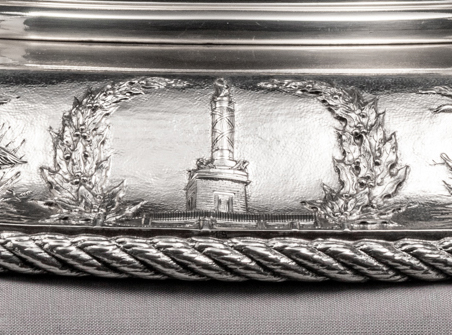
Battle Monument - Congress Hall (number 17)
Scenes on the reverse (left to right):During the Revolutionary war, Congress decided to move the seat of government from Philadelphia further south following Washington’s retreat after the Battle of White Plains. On December 20, 1776 Congress met for the first time in Baltimore at "Congress Hall," which stood at the southwest corner of Liberty and Baltimore Streets. Congress decided to use the private residence of Henry Fite, who rented it to the Congress for 60 pounds, instead of the local courthouse. Congress continued to meet at "Congress Hall" until February 27, 1777, when they voted to return to Philadelphia after the victories of Trenton and Princeton.
Most notably, on December 27, 1776 Congress voted to expand General Washington’s ability to make decisions about the war including authorizing the raising of sixteen additional battalions of infantry, with a proportionate total of cavalry and artillery for six months. While there was inadequate representation from various colonies throughout the session, Samuel Adams remarked, “We have done more important business in three weeks than we had done, and I believe should have done, at Philadelphia, in six months.”
“Congress Hall” was destroyed by fire on September 4, 1860.

Congress Hall -
First Columbus Monument (number 14)
The Columbus Monument was donated by Charles François Adrian de Paulmier, Chevalier d'Anmour, in 1792 to commemorate the tricentennial anniversary of Columbus's arrival in America. The Chevalier was France’s first post-Revolutionary representative in Baltimore. The obelisk is 44 feet tall and consists of a brick base covered in stucco.
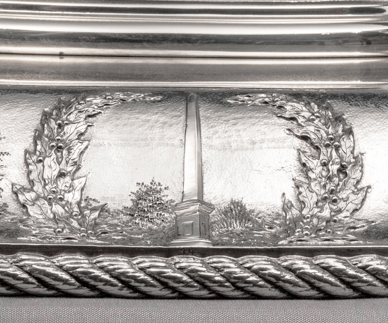
First Columbus Monument Ladle
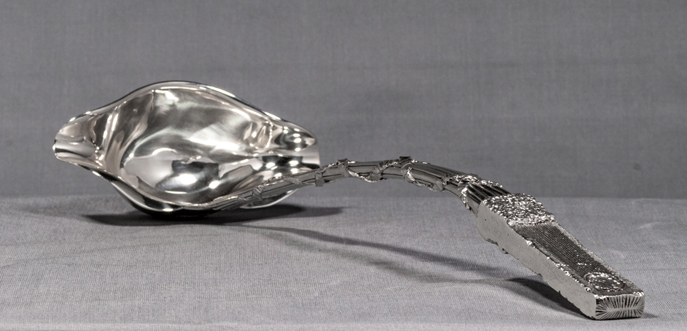
Maker: Samuel Kirk & Sons (1815-1979)
1. Handle, Mason Dixon Crownstone
Date: 1906
Medium: Sterling Silver
Dimensiions: Overall length, 18"; Overall width, 5 ¾"; Width of handle, 1"
Accession Number: MSA SC 1545-0929-1The handle of the ladle is formed from a reproduction of a “crownstone” marker of the Mason-Dixon Line. These large limestone markers were placed every five miles along the Mason-Dixon Line, and were decorated with the coats-of-arms of Maryland and Pennsylvania.
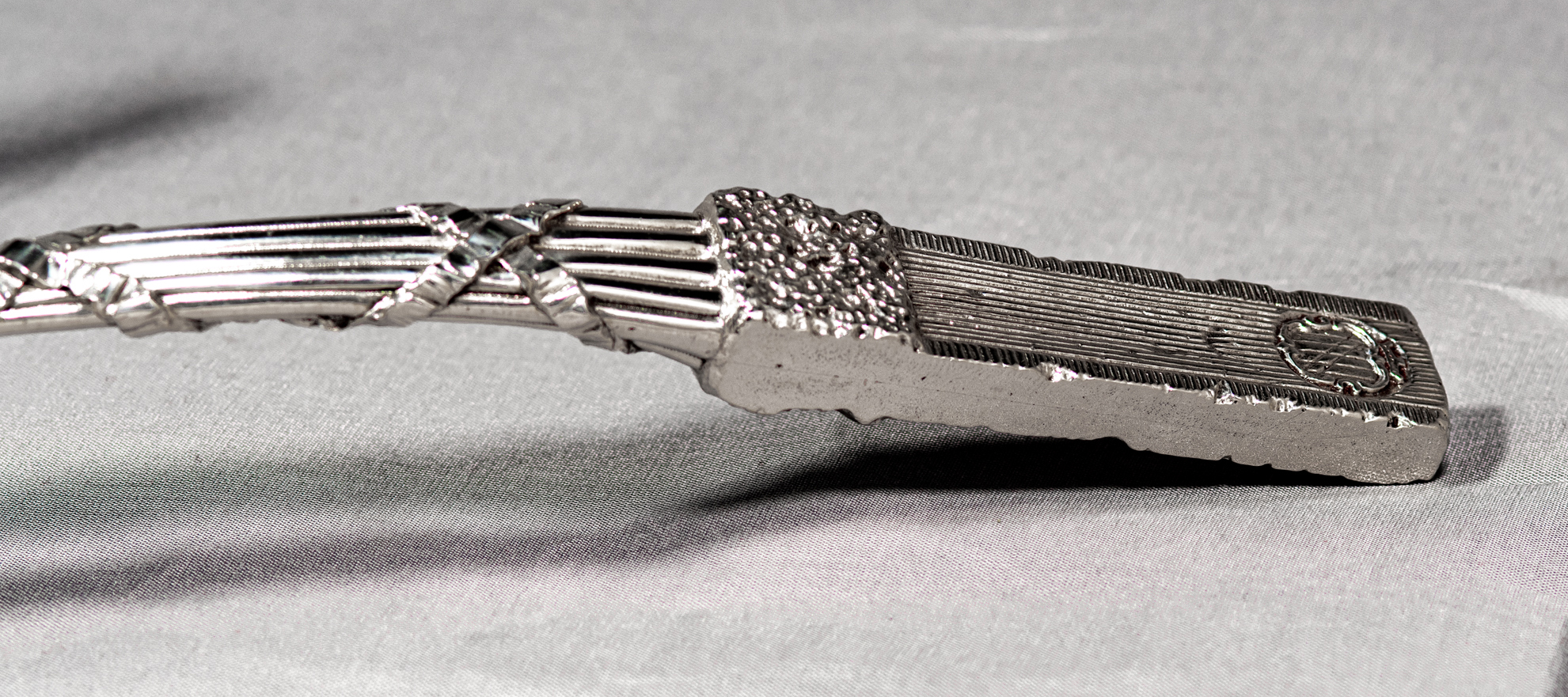
Mason Dixon Crownstone
This web site is presented for reference purposes under the doctrine of fair use. When this material is used, in whole or in part, proper citation and credit must be attributed to the Maryland State Archives. PLEASE NOTE: The site may contain material from other sources which may be under copyright. Rights assessment, and full originating source citation, is the responsibility of the user.
© Copyright August 07, 2024 Maryland State Archives
- Battle Monument (number 15)
- Captain John Rodgers (1798-1838)

